Sherwood RD-6506 User Manual [de]

 6505(G) cover_5lan_cover.qxp 2011-04-14 9:43 1
6505(G) cover_5lan_cover.qxp 2011-04-14 9:43 1
OPERATING INSTRUCTIONS
BEDIENUNGSANLEITUNG
MODE D'EMPLOI
INSTRUCCIONES DE FUNCIONAMIENTO
ИНСТРУКЦИЯ ПО ЭКСПЛУАТАЦИИ
RD-6506
AUDIO/VIDEO RECEIVER AUDIO/VIDEO RECEIVER RECEPTEUR AUDIO/VIDEO RECEPTOR DE AUDIO/VIDEO АУДИО/ВИДЕО ПРИЕМНИК
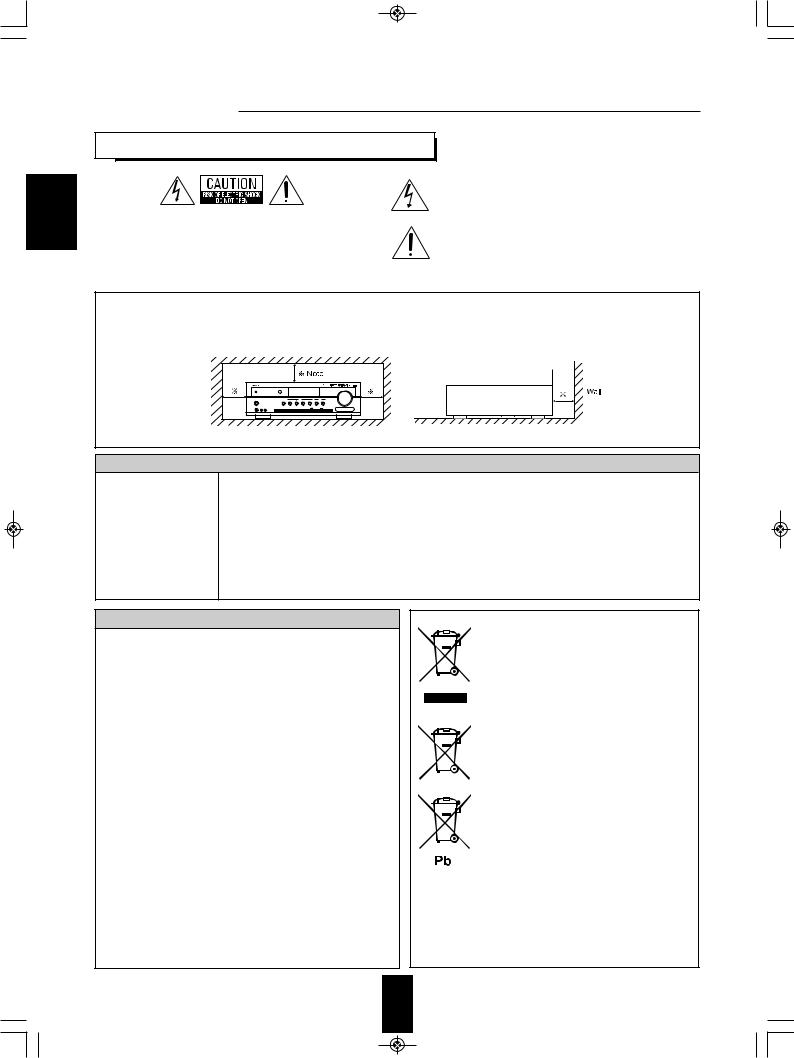
 RD-6506(G)_ENG_110330_RD-6506(G)_ENG 2011-04-14 9:29 2
RD-6506(G)_ENG_110330_RD-6506(G)_ENG 2011-04-14 9:29 2
ENGLISH
Introduction
READ THIS BEFORE OPERATING YOUR UNIT
|
|
|
|
This symbol is intended to alert the user to the presence of |
|
|
|
|
uninsulated "dangerous voltage" within the product's |
|
|
|
|
enclosure that may be of sufficient magnitude to constitute |
|
|
|
|
a risk of electric shock to persons. |
CAUTION |
: TO REDUCE THE RISK OF ELECTRIC SHOCK, |
|
|
|
|
|
|
||
|
|
This symbol is intended to alert the user to the presence of |
||
|
DO NOT REMOVE COVER (OR BACK). |
|
|
|
|
NO USER-SERVICEABLE PARTS INSIDE. |
|
|
important operating and maintenance (servicing) |
|
REFER SERVICING TO QUALIFIED SERVICE |
|
|
|
|
|
|
instructions in the literature accompanying the appliance. |
|
|
PERSONNEL. |
|
|
|
|
|
|
|
WARNING : TO REDUCE THE RISK OF FIRE OR ELECTRIC SHOCK, DO NOT EXPOSE THIS APPLIANCE TO RAIN OR MOISTURE.
Caution regarding installation
Note : For heat dispersal, do not install this unit in a confined space such as a bookcase or similar enclosure.
Be sure to leave a space around this unit equal to, or greater than, shown below. Left, right and rear sides : 20 cm, top side : 40 cm
Do not block ventilation openings or stack other equipment on the top.
FOR YOUR SAFETY
EUROPE |
220 V |
|
- |
||
AUSTRALIA |
||
240 V |
||
|
||
|
|
Units shipped to Australia are designed for operation on 230 V AC only.
To ensure safe operation, the three-pin plug supplied must be inserted only into a standard three-pin power point which is effectively earthed through the normal household wiring. Extension cords used with the equipment must be three-core and be correctly wired to provide connection to earth.
Improper extension cords are a major cause of fatalities. The fact that the equipment operates satisfactorily does not imply that the power point is earthed and that the installation is completely safe. For your safety, if in any doubt about the effective earthing of the power point, consult a qualified electrician.
PAN-EUROPEAN UNIFIED VOLTAGE
All units are suitable for use on supplies 220-240 V AC.
CAUTION
• Leave a space around the unit for sufficient ventilation.
• Avoid installation in extremely hot or cold locations, or in an area that is exposed to direct sunlight or heating equipment.
• Keep the unit free from moisture, water, and dust.
• Do not let foreign objects in the unit.
• The ventilation should not be impeded by covering the ventilation openings with items, such as newspapers, table-cloths, curtains, etc.
• No naked flame sources, such as lighted candles, should be placed on the unit.
• Please be care the environmental aspects of battery disposal.
• The unit shall not be exposed to dripping or splashing for use.
• No objects filled with liquids, such as vases, shall be placed on the unit.
• Do not let insecticides, benzene, and thinner come in contact with the set.
• Never disassemble or modify the unit in any way. ■Notes on the AC power cord and the wall outlet.
•The unit is not disconnected from the AC power source(mains) as long as it is connected to the wall outlet, even if the unit has been turned off.
•To completely disconnect this product from the mains, disconnect the plug from the wall socket outlet.
•When setting up this product, make sure that the AC outlet you are using is easily accessible.
•Disconnect the plug from the wall outlet when not using the unit for long periods of time.
Information for Users on Collection and Disposal of Old Equipment and used Batteries
These symbols on the products, packaging, and/or accompanying documents mean that used electrical and electronic products and batteries should not be mixed with general household waste. For proper treatment, recovery and recycling of old products and used batteries, please take them to applicable collection points, in accordance with your national legislation.
By disposing of these products and batteries correctly, you will help to save valuable resources and prevent any potential negative effects on human health and the environment which could otherwise arise from inappropriate waste handling.
For more information about collection and recycling of old products and batteries, please contact your local municipality, your waste diposal service or the point of sale where you purchased the items.
[Information on Disposal in other Countries outside the European Union]
These symbols are only valid in the European Union. If you wish to discard these items, please contact your local authorities or dealer and ask for the correct method of diposal.
Note for the battery symbol (bottom two symbol examples):
The sign Pb below the symbol for batteries indicates that this batteries contains lead.
2

 RD-6506(G)_ENG_110330_RD-6506(G)_ENG 2011-04-14 9:29 3
RD-6506(G)_ENG_110330_RD-6506(G)_ENG 2011-04-14 9:29 3
CONTENTS
Introduction |
|
|
|
|
|
|
|
• READ THIS BEFORE OPERATING YOUR UNIT |
| |
2 |
|||||
System Connections |
|
| |
4 |
|
|
|
|
Front Panel Controls |
|
| |
10 |
|
|
|
|
Remote Controls |
| |
12 |
|
|
|
|
|
• REMOTE CONTROL OPERATION RANGE |
|
| 13 |
|
||||
• LOADING BATTERIES |
| |
13 |
|
|
|
|
|
Operations |
|
|
|
|
|
|
|
• LISTENING TO A PROGRAM SOURCE |
|
| |
14 |
|
|||
• SURROUND SOUND |
|
| |
16 |
|
|
|
|
• ENJOYING SURROUND SOUND |
| |
17 |
|
|
|||
• LISTENING TO RADIO BROADCASTS |
|
| |
22 |
|
|||
• LISTENING TO RDS BROADCASTS(FM ONLY) |
| |
24 |
|||||
(RDS Tuner(Regional Option for some countries in Europe, etc.))
• RECORDING |
| |
26 |
|
|
|
• OTHER FUNCTIONS |
| |
27 |
|
||
• CONFIRMING THE HDMI FUNCTION |
| 28 |
||||
System Setup |
| |
29 |
|
|
|
• SETTING THE SYSTEM |
| |
31 |
|
||
• SETTING THE INPUT |
| |
33 |
|
||
• SETTING THE SPEAKER SETUP |
| 34 |
||||
• SETTING THE CH LEVEL |
| |
38 |
|
||
• SETTING THE PARAMETER |
|
| |
40 |
||
• SETTING THE HDMI |
| |
42 |
|
||
Troubleshooting Guide |
|
| |
44 |
|
|
Specifications |
| |
45 |
|
|
|
ENGLISH
3

 RD-6506(G)_ENG_110330_RD-6506(G)_ENG 2011-04-14 9:29 4
RD-6506(G)_ENG_110330_RD-6506(G)_ENG 2011-04-14 9:29 4
ENGLISH
System Connections
•Please be certain that this unit is unplugged from the AC outlet before making any connections.
•Since different components often have different terminal names, carefully read the operating instructions of the component connected.
•Be sure to observe the color coding when connecting audio, video and speaker cords.
•Make connections firmly and correctly. If not, it can cause loss of sound, noise or damage to the receiver.
2,3 |
4 |
8 |
3 |
5 |
1 |
2 |
7 |
MONITOR |
|
|
|
|
|
|
|
|
|
|
|
|
|
|
|
|
|
OUT |
|
|
|
|
|
|
|
|
|
|
|
|
|
|
|
|
|
|
|
|
|
|
|
|
|
|
|
Manufactured under license from Dolby Laboratories. Dolby, Pro Logic, and the double-D symbol are |
|
|
|
||||
|
|
|
|
|
|
|
|
|
|
trademarks of Dolby Laboratories. |
|
|
|
|
|
|
|
|
|
|
|
|
|
|
|
|
|
Manufactured under license under U.S. Patent #’s: 5,451,942 5,956,674 5,974,380 5,978,762 6,487,535 & |
N18041 |
RD-6506 |
|||||
|
|
|
|
|
|
|
|
|
|
DTS Digital Surround and the DTS logos are trademarks of DTS, Inc. © DTS, Inc. All Rights Reserved. |
|||||||
|
|
|
|
|
|
|
|
|
|
other U.S. and worldwide patents issued & pending. DTS and the Symbol are registered trademarks & |
|
|
|
||||
CD |
COAX 1 |
|
|
|
|
|
|
|
|
|
|
|
|
|
AUDIO/VIDEO RECEIVER |
|
|
|
VIDEO 2) |
|
|
|
|
|
|
|
|
|
|
|
|
|
|
||
|
|
|
|
|
|
|
|
|
|
FRONT |
SURROUND |
CENTER |
POWER SOURCE |
230V |
50Hz |
||
|
|
|
|
|
|
|
|
|
|
POWER CONSUMPTION |
200W |
||||||
|
|
|
IN |
|
OUT |
|
|
|
|
(6 |
) |
(6 |
) |
(6 ) |
|
|
|
|
|
R |
R |
|
|
|
|
R |
L |
R |
L |
|
|
DESIGNED IN USA |
|||
|
COAX 2 |
L |
L |
|
|
|
|
|
|
|
|
|
|
ASSEMBLED IN CHINA |
|||
VIDEO 2 |
(CD) |
|
|
|
|
TAPE |
|
GND |
IN |
OUT |
|
|
|
|
|
|
|
|
|
|
|
CD |
|
|
|
|
|
|
|
|
|
||||
|
|
|
|
|
|
|
VIDEO 2 |
MONITOR |
|
|
|
|
|
|
|
||
|
|
|
|
|
|
|
|
|
|
OUT |
|
|
|
|
|
|
|
|
OPT |
|
|
2 |
|
1SUBWOOFER |
LOOP |
|
|
|
|
|
|
SN. |
|
|
|
|
(VIDEO 1) |
|
|
VIDEO |
|
VIDEO |
OUT |
|
|
|
|
|
|
|
|
|
|
|
|
|
|
|
|
|
|
AM |
|
|
|
|
|
|
|
|
|
VIDEO 1 |
|
|
|
|
|
|
|
|
|
|
|
|
|
|
|
|
|
|
|
|
|
VIDEO 1 |
|
TAPE |
|
|
|
|
|
|
|
|
|
|
|
|
|
|
|
|
IN |
|
|
FM 75 |
VIDEO 1 |
VIDEO 1 |
|
|
|
|
AVIS : RISQUE DE CHOC ELECTRIQUE-NE PAS OUVRIR. |
||
|
|
|
|
|
|
|
|
|
|
|
|
||||||
HDMI |
DIGITAL IN |
|
|
AUDIO |
|
|
|
ANTENNA |
VIDEO |
|
SPEAKERS |
|
|
||||
|
|
|
|
|
|
|
|
WARNING : SHOCK HAZARD-DO NOT OPEN. |
|||||||||
2 |
3 |
6 |
1. CONNECTING ANTENNAS
GND
AM
LOOP
FM 75
ANTENNA
•Change the position of the FM indoor antenna until you get the best reception of your favorite FM stations.
GND
AM
LOOP
FM 75
ANTENNA
•A 75Ω outdoor FM antenna may be used to further improve the reception. Disconnect the indoor antenna before replacing it with the outdoor one.
GND
AM
LOOP
FM 75
ANTENNA
•Place the AM loop antenna as far as possible from the receiver, TV set, speaker cords and the AC input cord and set it to a direction for the best reception.
•If the reception is poor with the AM loop antenna, an AM outdoor antenna can be used in place of the AM loop antenna.
4

 RD-6506(G)_ENG_110330_RD-6506(G)_ENG 2011-04-14 9:29 5
RD-6506(G)_ENG_110330_RD-6506(G)_ENG 2011-04-14 9:29 5
2. CONNECTING VIDEO COMPONENTS
•The jacks of VIDEO 1 may also be connected to a DVD recorder or other digital video recording component. For details, refer to the operating instructions of the component to be connected.
•The jacks of VIDEO 2 can also be connected to an additional video component such as a cable TV tuner or satellite system.
•There are (composite) VIDEO jacks for analog video connections and the HDMI connectors for digital video and audio connections.
•For your reference, the excellence in picture quality is as follows : "HDMI” > "(composite) VIDEO".
■Notes :
•When recording video program sources through the (composite) VIDEO 1 OUT jack or viewing video program sources through the (composite) MONITOR OUT jack, you must connect the (composite) VIDEO IN jack to the video playback components such as BD player, DVD player, etc.
ENGLISH
MONITOR |
|
|
OUT |
|
|
VIDEO 2 |
|
|
VIDEO 1 |
VIDEO 2 |
VIDEO 1 |
|
|
|
|
VIDEO 1 |
|
|
|
IN |
HDMI |
AUDIO |
|
IN OUT
VIDEO 2 MONITOR OUT
VIDEO 1 VIDEO 1
VIDEO
5
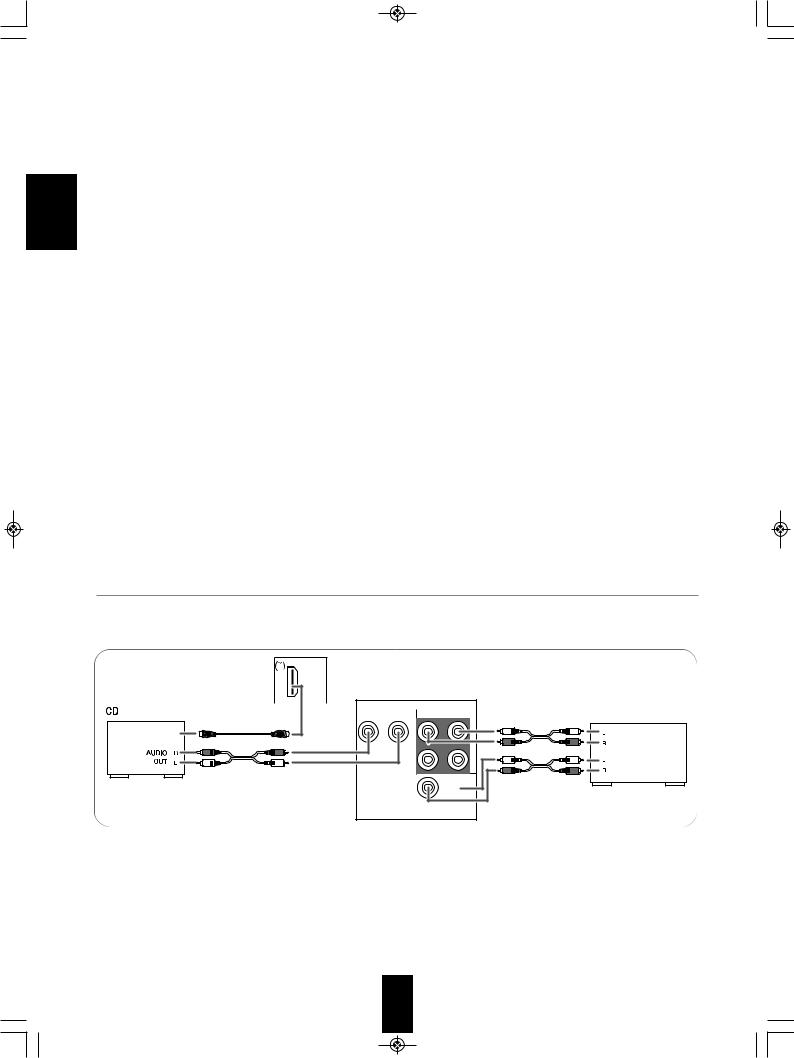
 RD-6506(G)_ENG_110330_RD-6506(G)_ENG 2011-04-14 9:29 6
RD-6506(G)_ENG_110330_RD-6506(G)_ENG 2011-04-14 9:29 6
ENGLISH
Continued
■HDMI (High Definition Multimedia Interface) connection : (*)
•You can connect the source component (DVD player, etc.) to the display component (TV, projector, etc.) through this receiver with using a commercially available HDMI cord.
•The HDMI connection can carry uncompressed digital video signals and digital audio signals.
•The HDMI video stream signals (video signals) are theoretically compatible with DVI-D. When connecting to a TV monitor, etc., equipped with DVI-D connector, it is possible to connect using a commercially available HDMI-DVI converter cord.
Since the HDMI-to-DVI connection cannot carry any audio signals, set the HDMI AUDIO OUT to AMP to hear the HDMI digital audio signals on this receiver.(For details, refer to "When selecting the HDMI AUDIO OUT" on page 42.)
■Copyright protection system
•This unit supports HDCP (High-bandwidth Digital Contents Protection), technology to protect copyright of digital video signals against illegal duplication. HDCP must also be supported on the components connected to this unit.
•HDMI, the HDMI logo and High-Definition Multimedia Interface are trademarks or registered trademarks of HDMI licensing LLC.
■Notes :
•For stable signal transfer, we recommend using HDMI cables that are a maximum of 5 meters in length.
•Among the components that support HDMI, some components can control other components via the HDMI connector.
For details on the HDMI function, refer to “CONFIRMING THE HDMI FUNCTION” on page 28 and “SETTING THE HDMI” on page 42.
•The audio signals from the HDMI connector (including the sampling frequency and bit length) may be limited by the component that is connected.
•The video signals will not be output properly if a component incompatible with HDCP is connected.
•If the resolutions of the video signals which are output from the MONITOR OUTs and your monitor TV are not matched, the picture is not clear, natural or displayed. In this case, change the setting of the resolution on the source component (BD player, etc.) to one which the monitor TV can handle. (For details, refer to the operating instructions of the source component.)
•When you want to enjoy only the picture on your TV, not the sound, you should set the HDMI AUDIO OUT to AMP not to output the digital audio signal from the HDMI MONITOR OUT of this receiver. (For details, refer to "When selecting the HDMI AUDIO OUT" on page 42.)
3.CONNECTING AUDIO COMPONENTS
•The TAPE IN/OUT jacks can be connected to audio recording equipment such as a tape deck, an MD recorder, etc.
•The HDMI IN of CD can be connected to an additional video component without analog video jacks.
|
CD |
|
|
|
|
CD player, BD player, Video game player, etc. |
|
IN |
|
OUT |
TAPE Tape deck, MD recorder, etc. |
R |
L |
R |
L |
||
HDMI OUT |
|
|
CD |
TAPE |
AUDIO |
|
|
|
|
|
IN |
1 |
|
|
VIDEO |
AUDIO |
|
OUT |
||
|
 TAPE
TAPE
IN
AUDIO
6
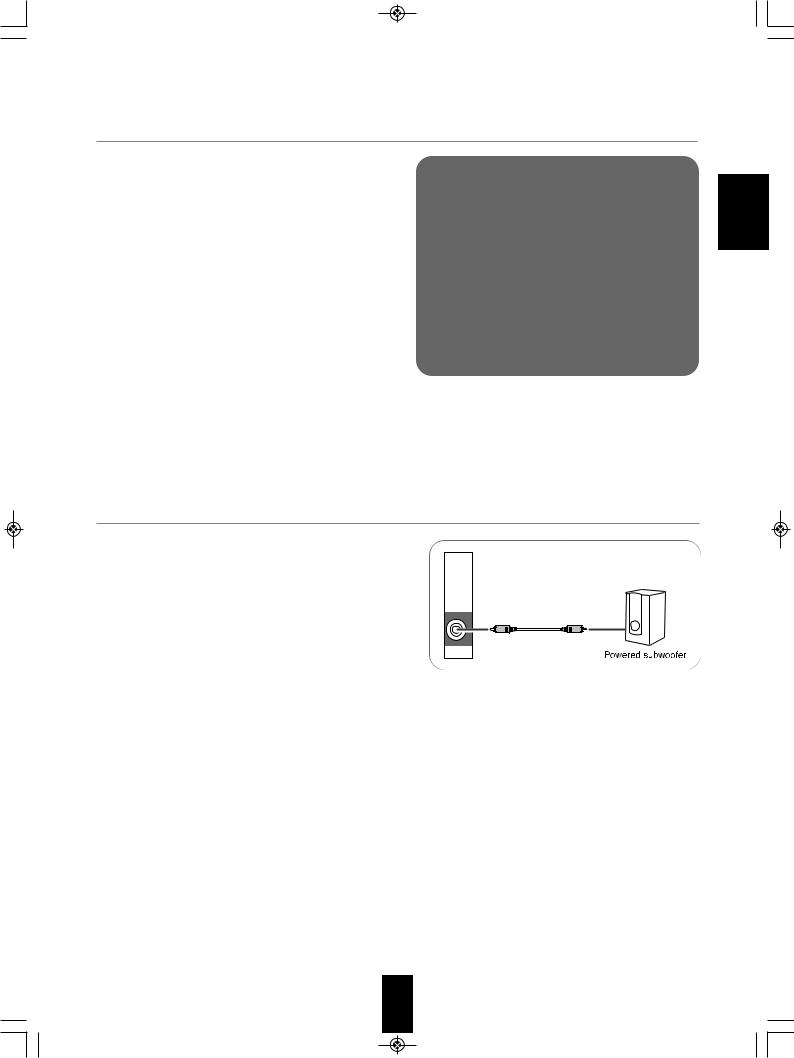
 RD-6506(G)_ENG_110330_RD-6506(G)_ENG 2011-04-14 9:29 7
RD-6506(G)_ENG_110330_RD-6506(G)_ENG 2011-04-14 9:29 7
4. CONNECTING DIGITAL INS
•The OPTICAL and the COAXIAL DIGITAL OUTs of the components that are connected to CD, VIDEO 1 and VIDEO 2 of this unit can be connected to these DIGITAL INs.
•A digital input should be connected to the components such as a
CD player, DVD player, etc. capable of outputting DTS Digital Surround, Dolby Digital or PCM format digital signals, etc.
•For details, refer to the operating instructions of the component connected.
•When making the COAXIAL DIGITAL connection, be sure to use a 75Ω COAXIAL cord, not a conventional AUDIO cord.
•Some of the commercially available optical fiber cords cannot be used for the equipment. If there is an optical fiber cord which cannot be connected to your equipment, consult your dealer or nearest service organization.
■Note :
•Be sure to make either a OPTICAL or a COAXIAL DIGITAL connection on each component. (You don’t need to do both.)
■Digital input default settings
COAX 1
VIDEO 2)
COAX 2 (CD)
OPT
(VIDEO 1)
DIGITAL IN
•If you connect the DIGITAL INs to your components, it is easier to do so following the default settings.
•If your DIGITAL connections are different from default settings, you should assign the DIGITAL INs you used with the “When selecting the AUDIO ASSIGN” procedure on page 33.
•The default settings are as follows :
OPTICAL IN : VIDEO 1, COAX 1 IN : VIDEO 2, COAX 2 IN : CD
5. CONNECTING SUBWOOFER PREOUT
•To emphasize the deep bass sounds, connect a powered subwoofer.
SUBWOOFER
OUT
ENGLISH
7
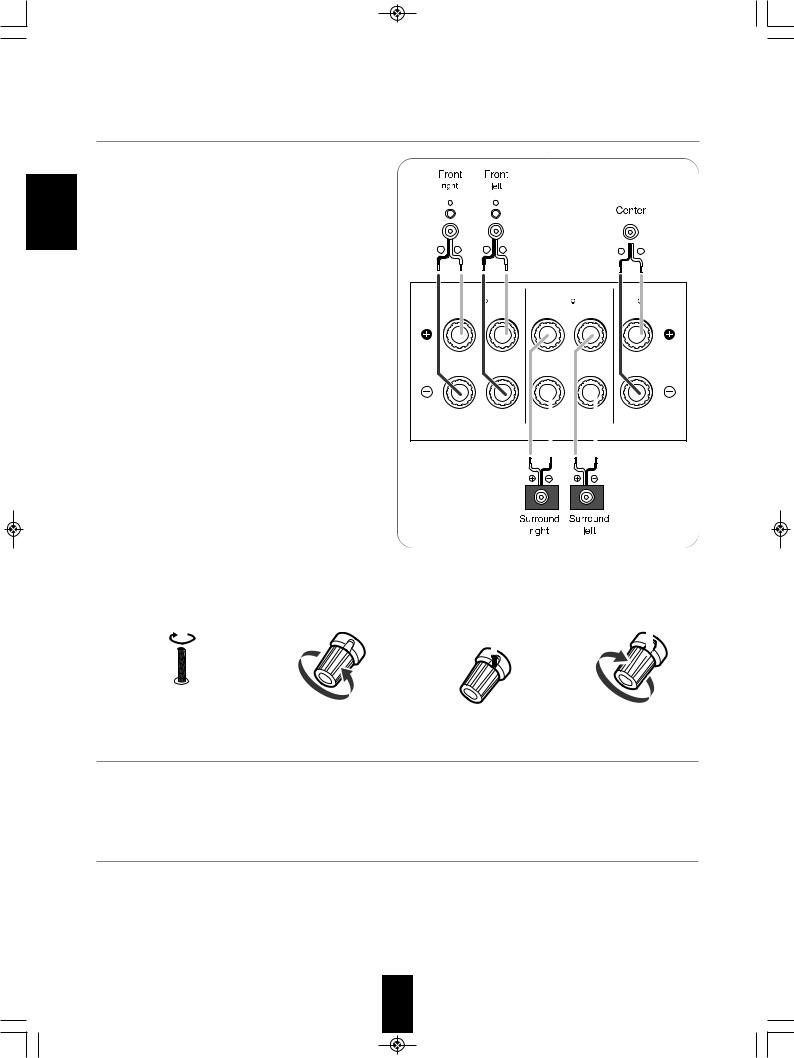
 RD-6506(G)_ENG_110330_RD-6506(G)_ENG 2011-04-14 9:29 8
RD-6506(G)_ENG_110330_RD-6506(G)_ENG 2011-04-14 9:29 8
ENGLISH
6. CONNECTING SPEAKERS
•Be sure to connect speakers firmly and correctly according to the channel(left and right) and the polarity (+ and -). If the connections are faulty, no sound will be heard from the speakers, and if the polarity of the speaker connection is incorrect, the sound will be unnatural and lack bass.
•For installing the speakers, refer to "Speaker placement" on page 9.
•After installing the speakers, first adjust the speaker settings according to your environment and speaker layout.
(For details, refer to "SETTING THE SPEAKER SETUP" on page 34.)
Caution :
•Be sure to use the speakers with the impedance of 6 ohms or above.
•Do not let the bare speaker wires touch each other or any metal part of this unit. This could damage this unit and/or the speakers.
•Never touch the speaker terminals while the AC input cord is connected to the wall AC outlet. Doing so could result in electric shocks.
|
|
|
|
|
|
|
|
|
|
|
|
|
|
|
|
|
|
|
|
|
|
|
|
|
|
|
|
|
|
|
|
|
|
|
|
|
|
|
|
|
|
|
|
|
|
|
|
|
|
|
|
|
|
|
|
|
|
|
|
|
|
SURROUND |
|
CENTER |
|||
|
|
|
|
|
|
|
|
|
|
|
|
|||||
|
|
|
|
|
|
|
|
|
|
|
|
|||||
|
|
|
|
|
FRONT |
|
||||||||||
|
|
|
|
|
|
|||||||||||
|
|
|
|
|
(6 ) |
|
|
|
(6 ) |
(6 ) |
|
|||||
R |
L |
R |
L |
SPEAKERS
■Connecting speaker wire
1. Strip away approx. 10 mm |
2. Loosen by turning the |
3. Insert the bare part of the |
4. Tighten by turning it |
||||||
(3/8 inch) of wire insulation, |
speaker terminal counter- |
wire. |
clockwise. |
||||||
then twist the wire ends |
clockwise. |
|
|
|
|
|
|
||
|
|
|
|
|
|
||||
|
|
|
|
|
|
||||
tight. |
|
|
|
|
|
|
|
||
|
|
|
|
|
|
|
|
|
|
|
|
|
|
|
|
|
|
|
|
|
|
|
|
|
|
|
|
|
|
|
|
|
|
|
|
|
|
|
|
7. AC INPUT CORD
• Plug the cord into a wall AC outlet.
8. TERMINAL FOR UPGRADES
•This terminal may be used in the future to update the operating software so that it will be able to support new digital audio formats, etc.
■Note :
•Programming for upgrades requires specialized programming knowledge and for that reason we recommend that it only be done by qualified installers.
8
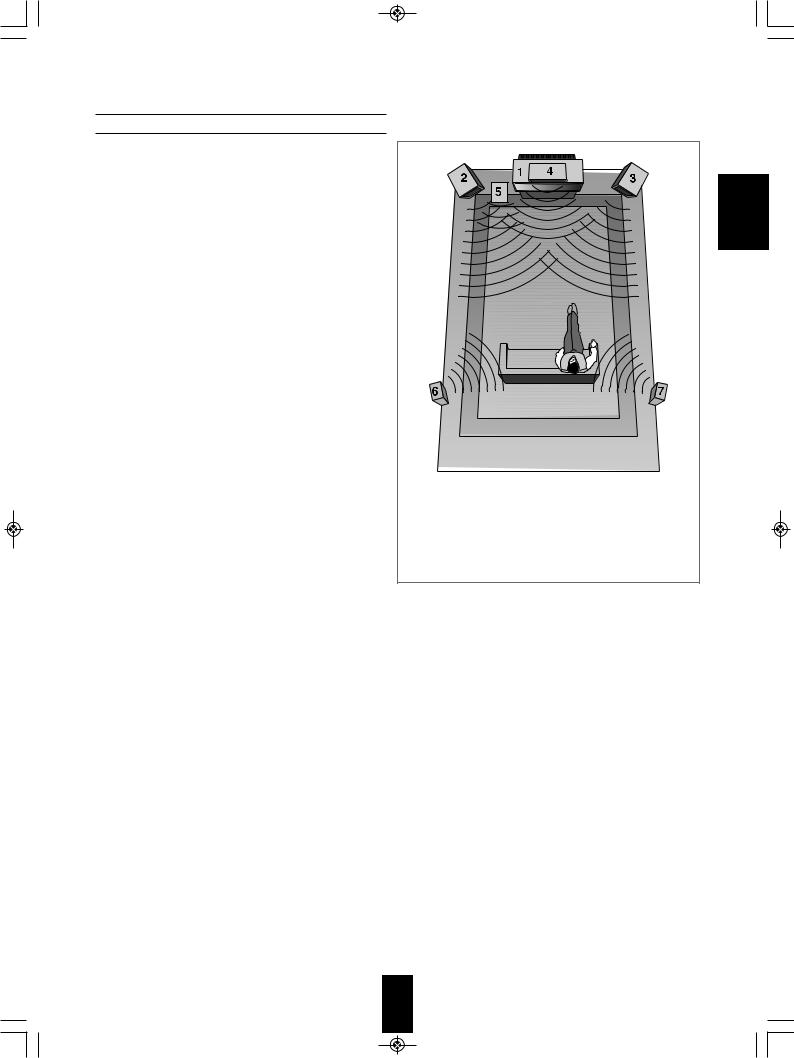
RD-6506(G)_ENG_110330_RD-6506(G)_ENG 2011-04-14 9:29 |
9 |
|
Speaker placement |
|
|
Ideal speaker placement varies depending on the size of |
|
|
your room and the wall coverings, etc. The typical example |
|
|
of speaker placement and recommendations are as follows : |
|
|
■Front left and right speakers and center speaker |
|
ENGLISH |
• Place the front speakers with their front surfaces as flush |
|
|
with TV or monitor screen as possible. |
|
|
• Place the center speaker between the front left and right |
|
|
|
|
|
speakers and no further from the listening position than the |
|
|
front speakers. |
|
|
• Place each speaker so that sound is aimed at the location |
|
|
of the listener’s ears when at the main listening position. |
|
|
■Surround left and right speakers |
|
|
• Place the surround speakers approximately 1 meter (40 |
|
|
inches) above the ear level of a seated listener on the |
|
|
direct left and right of them or slightly behind. |
|
|
■Subwoofer |
|
|
• The subwoofer reproduces powerful deep bass sounds. |
|
|
Place a subwoofer anywhere in the front as desired. |
|
|
■Notes : |
|
|
• When using a conventional TV, to avoid interference with |
|
|
the TV picture, use only magnetically shielded front left |
|
|
and right and center speakers. |
1. |
TV or Screen |
• To obtain the best surround effects, the speakers except |
||
the subwoofer should be full range speakers. |
2. |
Front left speaker |
|
3. |
Front right speaker |
|
4. |
Center speaker |
|
5. |
Subwoofer |
|
6. |
Surround left speaker |
|
7. |
Surround right speaker |
9
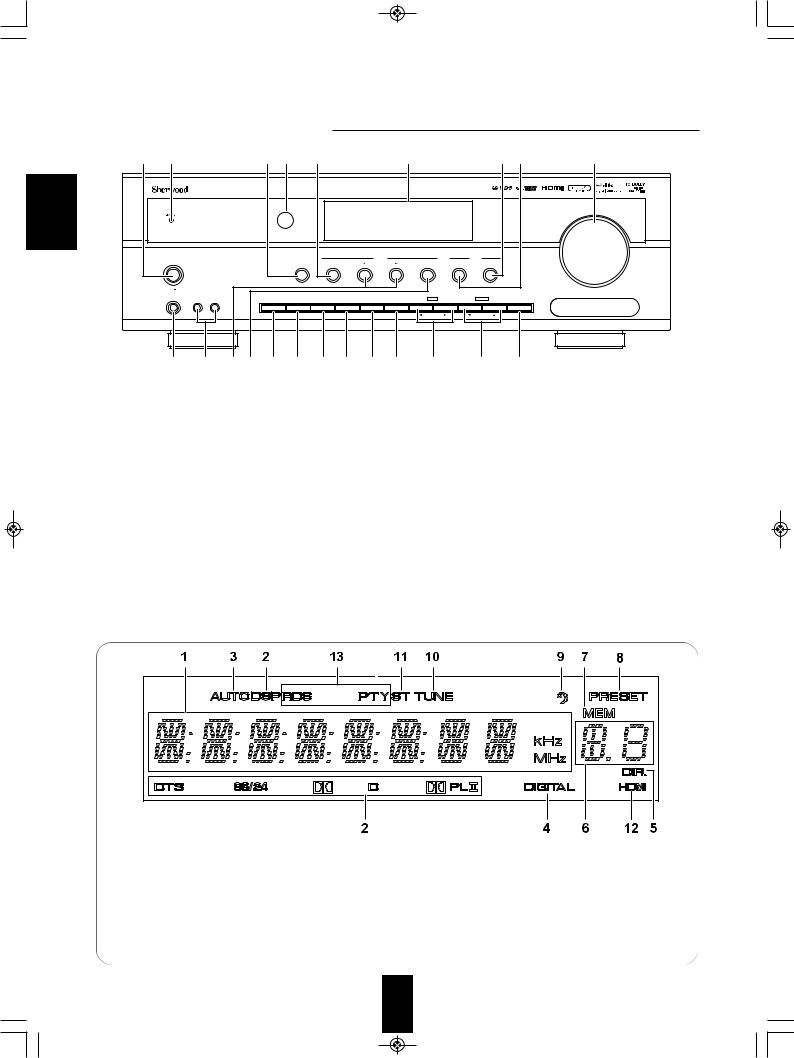
 RD-6506(G)_ENG_110330_RD-6506(G)_ENG 2011-04-14 9:29 10
RD-6506(G)_ENG_110330_RD-6506(G)_ENG 2011-04-14 9:29 10
Front Panel Controls |
|
|
|
|
|
|
|
|
|||||||
1 |
2 |
|
|
3 |
4 |
11 |
|
|
5 |
|
|
7 |
6 |
8 |
|
ENGLISH |
|
AUDIO/ VIDEO RECEIVER RD-6506 |
|
|
|
|
|
|
|
|
|
|
|
|
|
|
|
|
|
|
|
|
|
|
|
|
|
|
|
|
MASTER VOLUME |
|
POWER |
|
|
|
|
|
|
SOUND |
|
|
|
INPUT |
|
|
|
|
|
|
|
|
AUTO / MANUAL |
|
|
STEREO |
|
AUDIO |
|
|
|||
|
|
|
|
|
ON / STANDBY |
SURROUND |
VIDEO |
|
|
||||||
|
ON |
OFF |
|
|
|
|
|
|
|
|
|
|
|
|
|
|
PHONES |
AUX 2 |
SPEAKER |
AUDIO ASSIGN |
|
TONE |
CH.LEVEL |
SETUP |
ENTER / MEMO |
TUNE |
|
PRESET |
BAND |
|
|
|
|
AUX 1 |
|
|
|
||||||||||
|
|
|
|
ON / OFF |
RETURN |
|
|
|
MAIN MENU |
|
|
|
|
|
|
|
9 |
10 |
12 13 |
14 |
15 |
|
16 |
17 |
18 |
19 |
20 |
|
21 |
22 |
|
1. POWER switch |
12. SURROUND MODE SELECT (/) buttons |
|
2. STANDBY indicator |
13. |
STEREO button |
3. POWER ON/STANDBY button |
14. SPEAKER button |
|
4. REMOTE SENSOR |
15. AUDIO ASSIGN button |
|
5. FLUORESCENT DISPLAY |
16. TONE MODE button |
|
For details, see below. |
17. CHANNEL LEVEL button |
|
6. VIDEO INPUT SELECTOR button |
18. |
SETUP button |
7. AUDIO INPUT SELECTOR button |
19. ENTER/MEMORY button |
|
8. MASTER VOLUME knob |
20. |
TUNING UP/DOWN(+/-), |
9. HEADPHONE jack |
|
CURSOR LEFT/RIGHT(/) buttons |
10. AUX 1, 2 IN jacks |
21. PRESET UP/DOWN(+/-), |
|
For details, see next page. |
|
CURSOR UP/DOWN(▲/▼) buttons |
11. AUTO/MANUAL button |
22. |
BAND button |
■FLUORESCENT DISPLAY
1. |
Input, frequency, volume level, operating information, etc. |
8. |
PRESET indicator |
2. |
Surround mode indicators |
9. |
SLEEP indicator |
3. |
AUTO indicator |
10. |
TUNED indicator |
4. |
DIGITAL INPUT indicator |
11. |
STEREO indicator |
5. |
DIRECT indicator |
12. |
HDMI indicator |
6. |
Preset number display |
13. |
RDS indicators |
7. |
MEMORY indicator |
|
(Regional option for Europe, etc.) |
10
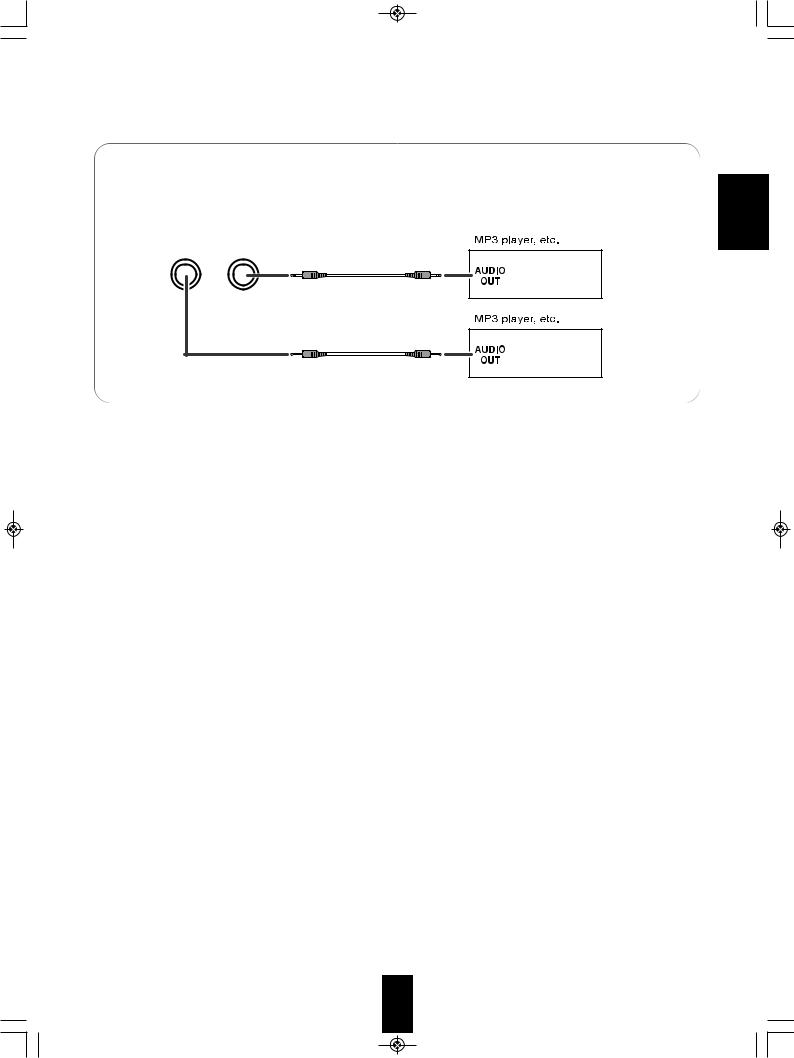
 RD-6506(G)_ENG_110330_RD-6506(G)_ENG 2011-04-14 9:29 11
RD-6506(G)_ENG_110330_RD-6506(G)_ENG 2011-04-14 9:29 11
■AUX 1, 2 IN JACKS
• The AUX 1, 2 IN jacks can be connected to additional audio components such as an MP3 player, etc.
■Note :
• When connecting these jacks to an MP3 player, etc., you should use the stereo mini cord, not a mono mini cord.
AUX 1 |
AUX 2 |
ENGLISH
11
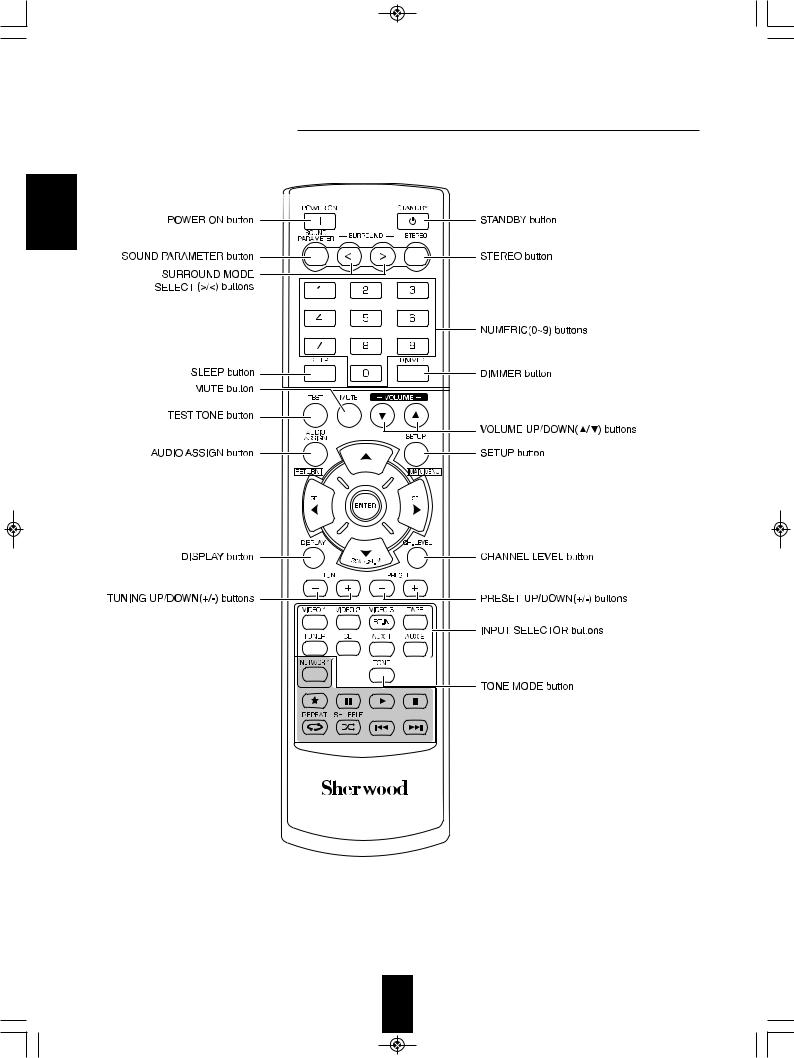
 RD-6506(G)_ENG_110330_RD-6506(G)_ENG 2011-04-14 9:29 12
RD-6506(G)_ENG_110330_RD-6506(G)_ENG 2011-04-14 9:29 12
Remote Controls
ENGLISH
 CURSOR CONTROL(
CURSOR CONTROL( ,
, ,
, ,
, ), ENTER </SEARCH MODE, SELECT
), ENTER </SEARCH MODE, SELECT  /
/ > buttons
> buttons  The functions in “< >” are regional option
The functions in “< >” are regional option
for Europe, etc.
 NETWORK CONTROL buttons
NETWORK CONTROL buttons
■Note:
• The VIDEO 3 and NETWORK CONTROL buttons are not available for this receiver.
12
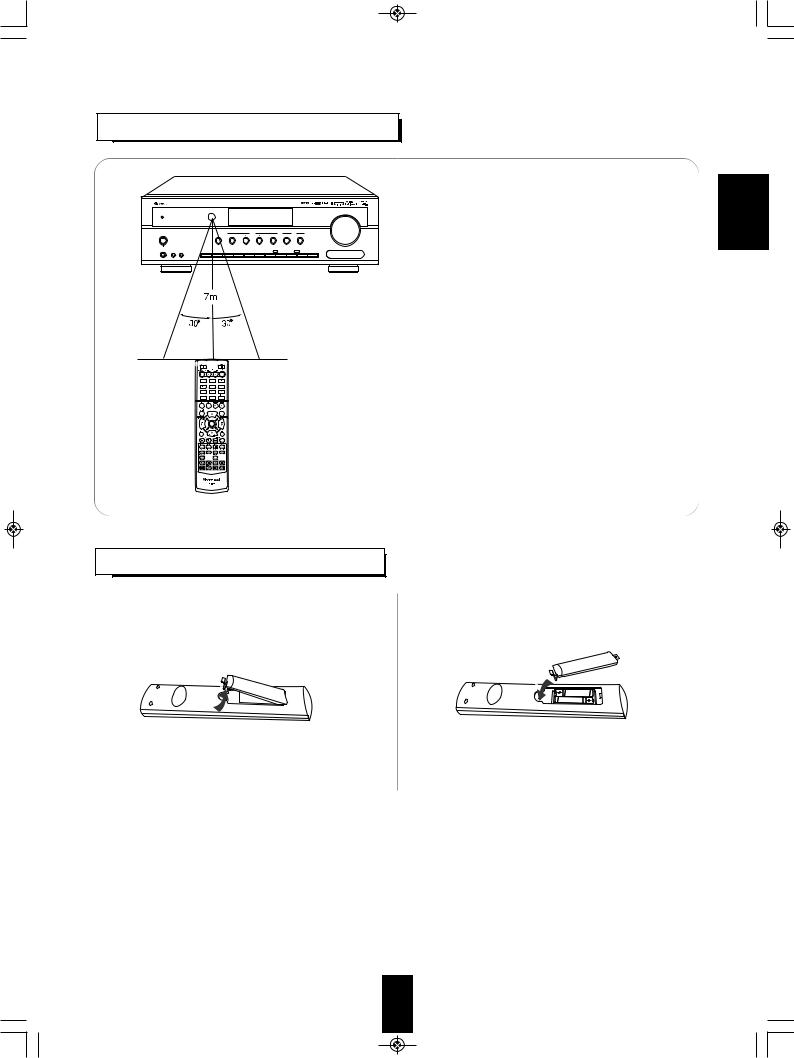
 RD-6506(G)_ENG_110330_RD-6506(G)_ENG 2011-04-14 9:29 13
RD-6506(G)_ENG_110330_RD-6506(G)_ENG 2011-04-14 9:29 13
REMOTE CONTROL OPERATION RANGE
AUDIO/ VIDEO RECEIVER RD-6506 |
|
ENGLISH |
|
MASTER VOLUME |
|
•Use the remote control unit within a range of about 7 meters (23 feet) and angles of up to 30 degrees aiming at the remote sensor.
LOADING BATTERIES
1. Remove the cover. |
2. Load two batteries ("AAA" size, 1.5 V) matching |
||||||
|
|
|
|
|
the polarity. |
||
|
|
|
|
||||
|
|
|
|
|
|
|
|
|
|
|
|
|
|
|
|
|
|
|
|
|
|
|
|
• Remove the batteries when they are not used for a long time.
• Do not use the rechargeable batteries (Ni-Cd type).
13
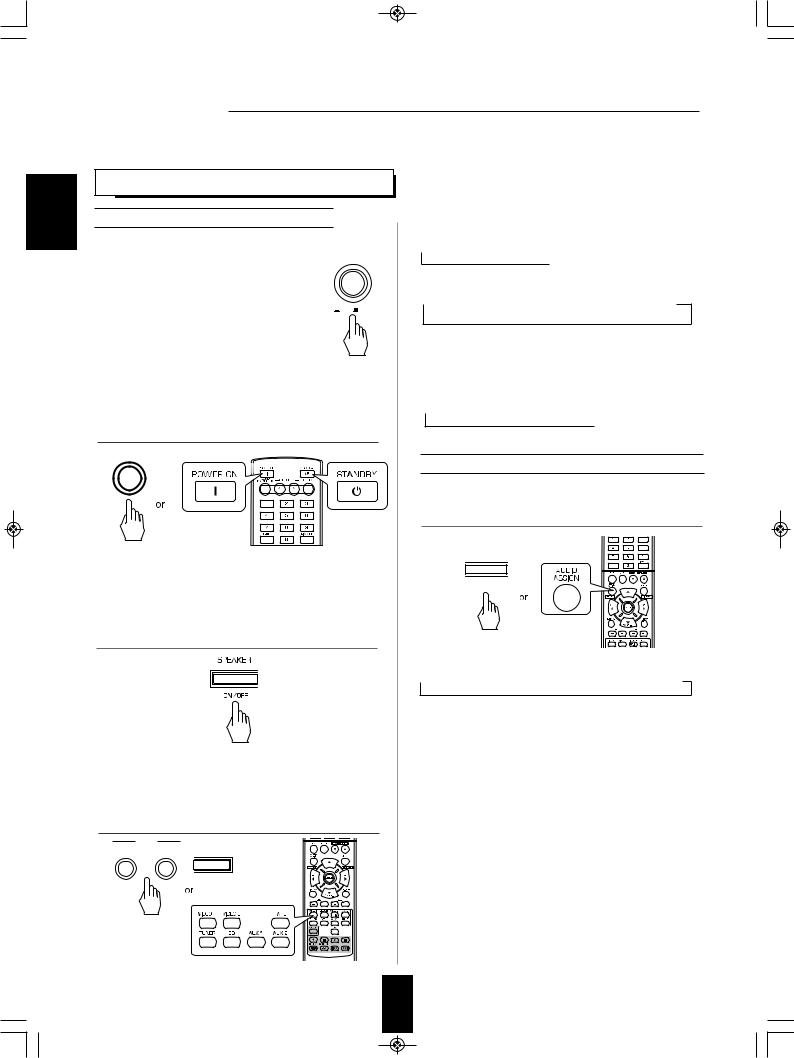
 RD-6506(G)_ENG_110330_RD-6506(G)_ENG 2011-04-14 9:29 14
RD-6506(G)_ENG_110330_RD-6506(G)_ENG 2011-04-14 9:29 14
ENGLISH
Operations
■Note : Before operating this receiver, first set this unit as desired for optimum performance, doing the system setup procedures. (For details, refer to "System Setup" on page 29.)
LISTENING TO A PROGRAM SOURCE
Before operation
• Enter the standby mode.
POWER
•The STANDBY indicator lights up.
This means that the receiver is not disconnected from the AC mains and a small amount of current is
retained to support the operation readiness. |
|
• To switch the power off, push the POWER switch again. |
ON OFF |
•Then the power is cut off and the STANDBY indicator goes off.
■Auto Power Save
•The auto power save is a function that automatically
turns the power off to enter the standby mode. When any button is not pressed for more than the time you set, it will function. (For details, refer to “When selecting the AUTO POWER SAVE” on page 31.)
1.In the standby mode, turn the power on.
ON / STANDBY
•Each time the POWER ON/STANDBY button on the front panel is pressed, the receiver is turned on to enter the operating mode or off to enter the standby mode.
•On the remote control, press the POWER ON button to enter the operating mode or press the STANDBY button to enter the standby mode.
2.Switch the speakers on.
•Then “SP ON” is displayed and the sound can be heard from the speakers connected to the speaker terminals.
•When using the headphones for private listening, press the SPEAKER button again to switch the speakers off(“SP OFF” is displayed).
3.Select the desired input source.
INPUT
VIDEO AUDIO BAND
•Each time the “VIDEO” button on the front panel is
pressed, the input source changes as follows: → VIDEO 1 →VIDEO 2 
•Each time the “AUDIO” button on the front panel is
pressed, the input source changes as follows: →CD → AUX 1 →TV* → AUX 2 → TAPE→ TUNER
(Frequency display)
* : Only when the HDMI CONTROL is set to ON, you can hear the digital audio signals from TV via a HDMI cable. (For details, refer to “When selecting the HDMI CONTROL” on page 42.)
•Each time the BAND button(or the TUNER button on the remote control) is pressed, the band changes as follows:
→FM ST → FM MONO → AM 
When CD, VIDEO 1 ~ 2 is selected as an input source
4. Select the digital or the analog input connected as
desired.
AUDIO ASSIGN
RETURN
•Each time this button is pressed, the corresponding input is selected as follows:
→ O(ptical) → C(oaxial) 1 → C(oaxial) 2 → A(nalog)
■Notes :
•When the HDMI IN connector is connected to your video component, you cannot assign the audio input as desired. (It means that only the HDMI digital audio signals can be heard.)
•When the HDMI IN connector is not connected (and the “HDMI” indicator flickers), you can assign the audio input.
•When AUX 1, AUX 2, TAPE or tuner is selected as an input source, the digital input cannot be selected.
•When the selected digital input is not connected, the “DIGITAL” indicator flickers and the analog input is automatically selected.
•The selected digital input or analog input is automatically assigned to the corresponding input source on the INPUT setup menu. (For details, refer to “SETTING THE INPUT” on page 33.)
•The sound from the component connected to the selected digital input can be heard regardless of the selected input source.
14

 RD-6506(G)_ENG_110330_RD-6506(G)_ENG 2011-04-14 9:29 15
RD-6506(G)_ENG_110330_RD-6506(G)_ENG 2011-04-14 9:29 15
5. Operate the selected component for playback.
•When playing back the program sources with surround sound, refer to “ENJOYING SURROUND SOUND” on page 17.
6.Adjust the (overall) volume.
MASTER VOLUME
DOWN UP
7. To mute the sound.
MUTE
•“MUTING” is displayed.
•To resume the previous sound level, press it again.
8.To listen with the headphones.
PHONES
•Be sure to switch the speakers off.
•When listening to a DTS or Dolby Digital program source, if the headphones are plugged in and the SPEAKER button is set to off, it enters the 2CH downmix mode automatically. (For details, refer to “2CH downmix mode”on page 17.)
■Note:
•Be careful not to set the volume too high when using headphones.
Adjusting the tone (bass and treble)
9. Enter the tone mode.
TONE
• The tone mode is displayed for several seconds.
10. Press the CURSOR LEFT( )/RIGHT( ) buttons to select the desired tone mode.
TUNE
•Each time these buttons are pressed, the tone mode is selected as follows :
OFF : To listen to a program source without the
↕tone effect.("DIR" lights up.)
ON : To adjust the tone for your taste.("DIR" goes off.)
■When the TONE is set to ON to adjust the tone
(bass and treble).
11. Press the CURSOR UP(▲)/DOWN(▼) buttons
to select the desired tone.
PRESET
•Each time these buttons are pressed, the tone is selected as follows:
→BASS ↔ TRE (treble) ↔ TONE: ON ←
12.Press the CURSOR LEFT( )/RIGHT( ) buttons to adjust the selected tone as desired.
•The tone level can be adjusted within the range of -10 ~
+10 dB.
•In general, we recommend the bass and treble to be adjusted to 0 dB (flat level).
•Extreme settings at high volume may damage your speakers.
•If the tone display disappears, start from the step 9 again.
ENGLISH
15
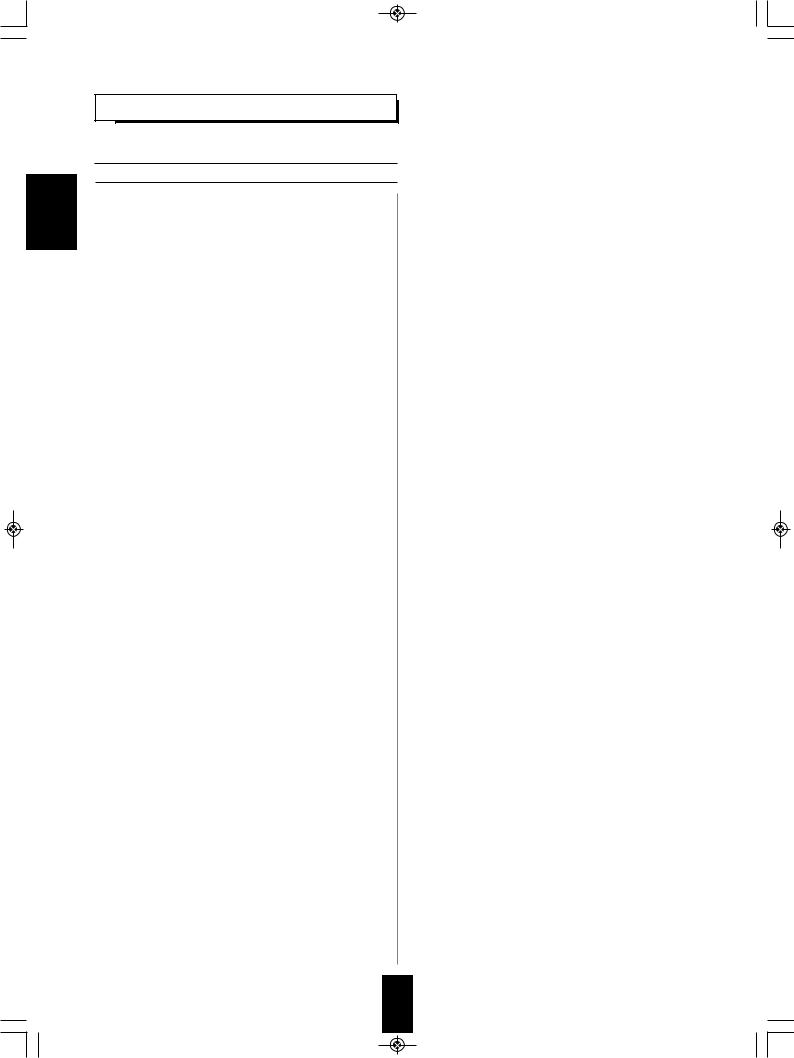
 RD-6506(G)_ENG_110330_RD-6506(G)_ENG 2011-04-14 9:29 16
RD-6506(G)_ENG_110330_RD-6506(G)_ENG 2011-04-14 9:29 16
ENGLISH
SURROUND SOUND
•This receiver incorporates a sophisticated Digital Signal Processor that allows you to create optimum sound quality and sound atmosphere in your personal Home Theater.
Surround modes
■DTS Digital Surround
DTS Digital Surround(also called simply DTS) supports up to 5.1 discrete channels and uses less compression for high fidelity reproduction. Use it with DVDs and CDs bearing the DTS logo.
■DTS 96/24
This is high resolution DTS with a 96 kHz sampling rate and 24 bit resolution, providing superior fidelity. Use it with DVDs bearing the DTS 96/24 logo.
Manufactured under license under U.S. Patent Nos: 5,956,674; 5,974,380; 6,487,535 & other U.S. and worldwide patents issued & pending. DTS, the Symbol, & DTS and the Symbol together are registered trademarks & DTS Digital Surround and the DTS logos are trademarks of DTS, Inc. Product includes software. DTS, Inc. All Rights Reserved.
■Dolby Digital
Dolby Digital is the multi-channel digital signal format developed by Dolby Laboratories. Discs bearing the Dolby Digital logo includes the recording of up to 5.1 channels of digital signals, which can reproduce much better sound quality, spatial expansion and dynamic range characteristics than the previous Dolby Surround effect.
■Dolby Pro Logic II surround
This mode applies conventional 2- channel signals such as digital PCM or analog stereo signals as well as Dolby Surround signals, etc. to surround processing to offer improvements over conventional Dolby Pro Logic circuits. Dolby Pro Logic ll surround includes 2 modes as follows:
•Dolby Pro Logic ll Movie
When enjoying movies, this mode allows you to further enhance the cinematic quality by adding processing that emphasizes the sounds of the action special effects.
•Dolby Pro Logic ll Music
When listening to music, this mode allows you to further enhance the sound quality by adding processing that emphasizes the musical effects.
■Dolby Pro Logic
This mode expands any 2-channel source(including Dolby Surround source) for 4 channel(front left, center, front right and surround) playback.
The surround channel is monaural, but is played through two surround speakers.
Manufactured under license from Dolby Laboratories. Dolby, Pro Logic, and the double-D symbol are registered trademarks of Dolby Laboratories.
•The following modes apply conventional 2-channel signals such as digital PCM or analog stereo signals to high performance Digital Signal Processor to recreate sound fields artificially. Select one of the 6 provided surround modes according to the program source you want to play.
■Theater
This mode provides the effect of being in a theater when watching a play.
■Movie
This mode provides the effect of being in a movie theater when watching a movie.
■Hall
This mode provides the ambience of a concert hall for classical music sources such as orchestral, chamber music or an instrumental solo.
■Game
This mode is suitable for video games.
■Stadium
This mode provides the expansive sound field to achieve the true stadium effect when watching baseball or soccer games.
■Multi CH Stereo
This mode is designed for playing background music. The front and surround channels create a stereo image that encompasses the entire area.
16
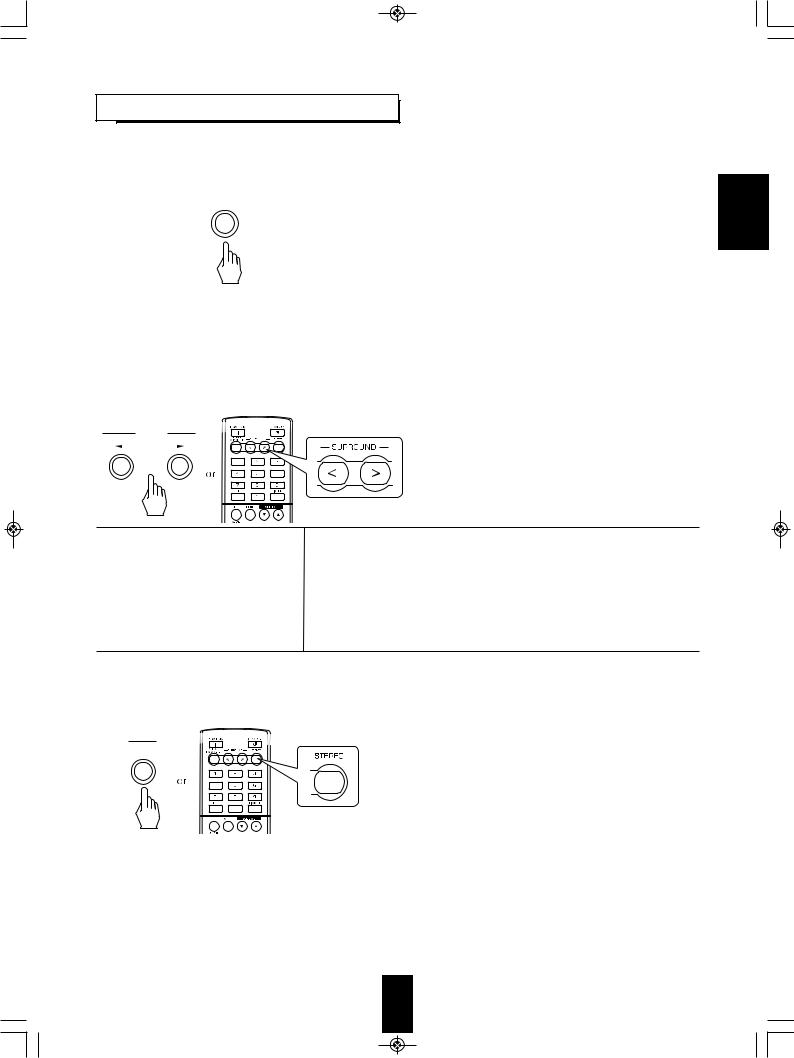
 RD-6506(G)_ENG_110330_RD-6506(G)_ENG 2011-04-14 9:29 17
RD-6506(G)_ENG_110330_RD-6506(G)_ENG 2011-04-14 9:29 17
ENJOYING SURROUND SOUND
■Note: Before surround playback, first perform the speaker setup procedure, etc. on the SETUP menu for optimum performance.
(For details, refer to "SETTING THE SPEAKER SETUP" on page 34.)
Depending on how to select a surround mode, select the auto surround mode or the manual surround mode.
AUTO/MANUAL
■Notes :
• Each time this button is pressed, the mode changes as follows :
Auto surround mode : The optimum surround mode will be
("AUTO" indicator |
automatically selected depending on the signal |
lights up.) |
format being input. |
Manual surround mode : You can select the desired of different |
|
("AUTO" indicator |
surround modes selectable for the signal |
goes off.) |
being input with using the SURROUND |
|
MODE SELECT (>/<) buttons. |
•When the SPEAKER button is set to off or “C(Center)” and “S(Surround)” are set to “NO”, the auto surround mode is invalid.
•Even when the auto surround mode is selected and the same type of digital signal format is being input, the optimum surround mode may vary depending on whether the speaker type is set to "NO" or not.
•When the auto surround mode is selected, the surround modes other than the optimum surround mode cannot be selected.
■When selecting the manual surround mode with pressing the AUTO/MANUAL button on the front panel
Select the desired surround mode.
SOUND |
• Each time the SURROUND MODE SELECT (>/<) |
SURROUND |
buttons are pressed, the surround mode changes |
|
depending on the input signal format as follows : |
ENGLISH
Signal format being input |
Selectable surround mode |
Dolby Digital EX 6.1 channel sources, |
DOLBY DIGITAL or <2 CH IN> *1 |
Dolby Digital 5.1 channel sources |
|
Dolby Digital 2 channel sources, |
DOLBY PLII MOVIE, DOLBY PLII MUSIC, THEATER, MOVIE, HALL, GAME, STADIUM, |
PCM (2 channel) sources, |
M.CH STEREO, DOLBY PRO LOGIC or <2 CH IN> *1 |
Analog stereo sources |
|
DTS sources, |
Corresponding DTS mode or <2 CH IN>*1 |
DTS 96/24 sources |
|
*1 : When “C(Center)” and “S(Surround)” are set to “NO”, any surround mode cannot be selected and the source can be reproduced either in the stereo mode or in the 2CH downmix mode.
■To cancel the surround mode for stereo operation
STEREO
■2CH downmix mode
•Depending on the signal format which is being input, either the stereo mode or the 2CH downmix mode is selected.
•To cancel either the stereo mode or the 2CH downmix mode, select the surround mode with using the SURROUND
MODE SELECT (>/<) buttons.
•This mode allows the multi-channel signals encoded in DTS or Dolby Digital format to be mixed down into 2 front channels and to be reproduced through only two front speakers or through headphones.
• When the SPEAKER button is set to off to listen with headphones hilew playing the multi-channel digital signals from DTS or
Dolby Digital sources, it will enter the 2CH downmix mode automatically.
17
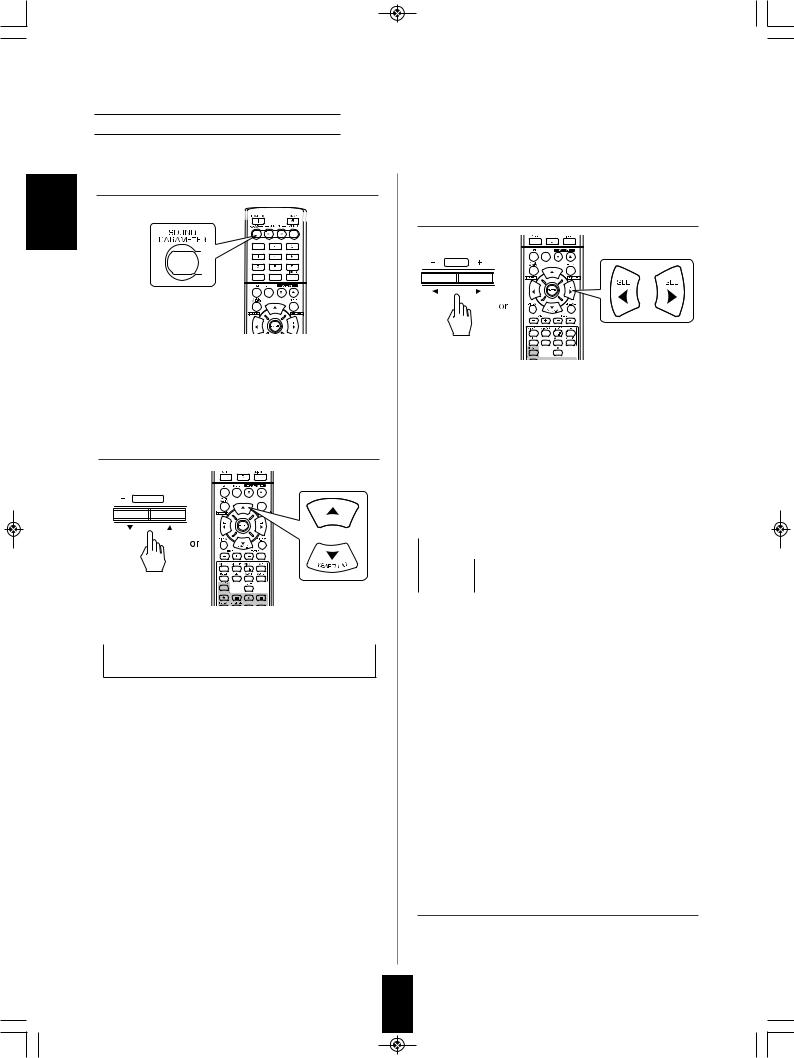
 RD-6506(G)_ENG_110330_RD-6506(G)_ENG 2011-04-14 9:29 18
RD-6506(G)_ENG_110330_RD-6506(G)_ENG 2011-04-14 9:29 18
ENGLISH
When adjusting the sound parameters
•While playing digital signals form Dolby Digital program source or listening in Dolby Pro Logic II Music mode, you can adjust their parameters for optimum surround effects.
1. Press the SOUND PARAMETER button.
•Then “DRC: ~” (or “PANO : ~ ”) is displayed for several seconds.
•If the parameter mode disappears, press this button again.
2.Press the CURSOR UP(▲)/DOWN(▼) buttons to select the desired parameter.
PRESET
•Each time these buttons are pressed, the parameter mode changes as follows:
→ "DRC" ↔ "PANO" ↔"C.WIDTH" ↔ "DIMEN" ← |
||
(Dynamic Range (Panorama) |
(Center width |
(Dimension |
Compression) |
control) |
control) |
•"DRC" can be selected only while playing digital signals from Dolby Digital source.
•"PANO", "C.WIDTH" and "DIMEN" can be selected only while listening in Dolby Pro Logic II Music mode.
3. Press the CURSOR LEFT( )/ RIGHT( ) buttons to adjust the selected parameter as desired.
TUNE
■When selecting the "DRC (Dynamic Range
Compression)"
•This function compresses the dynamic range of previously specified parts of the Dolby Digital sound track
(with extremly high volume) to minimize the difference in volume between the specified and non-specified parts.
This makes it easy to hear all of the sound track when watching movies at night at low levels.
■Note :
•In some Dolby Digital softwares, DRC setting may not be valid.
→ OFF : To turn off the DRC function. (Default value)
↕
MID
↕Higher compression
→MAX 
■When selecting the "PANO (Panorama)"
This mode extends the front stereo image to include the surround speakers for an exciting "wraparound" effect with side wall imaging.
Select "OFF" or "ON"(default value: OFF).
■When selecting the "C. WIDTH (Center width)" control
This adjusts the center image so it may be heard only from the center speaker, only from the left/right speakers as a phantom image, or from all three front speakers to varying degrees.
The control can be set in 8 steps from 0 to 7(default value :
3).
■When selecting the "DIMEN (Dimension)" control
This gradually adjusts the soundfield either towards the front or towards the rear. The control can be set in 7 steps from -3 to +3 (default value : 0).
4. Repeat the above steps 2 and 3 to adjust other parameters.
18
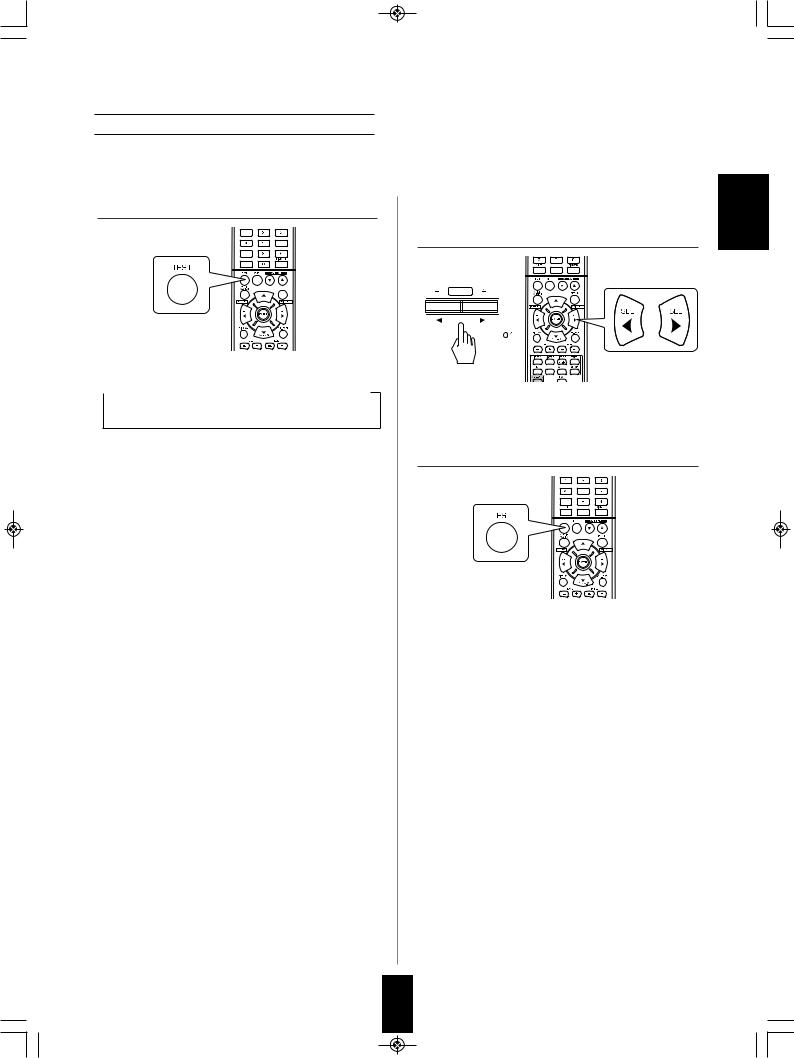
 RD-6506(G)_ENG_110330_RD-6506(G)_ENG 2011-04-14 9:29 19
RD-6506(G)_ENG_110330_RD-6506(G)_ENG 2011-04-14 9:29 19
Adjusting each channel level with test tone
• The volume level of each channel can be adjusted easily with the test tone function. ■Note : When the SPEAKER button is set to off, the test tone function does not work.
1. Enter the test tone mode.
•The test tone mode is displayed and will be heard from the speaker of each channel for 2 seconds as follows:
→ FL → C → FR → SR → SL → SW
Front |
Center Front |
Surround |
Surround Subwoofer |
Left |
Right |
Right |
Left |
•When the speaker setting is "NO", the test tone of the corresponding channel is not available.
2. At each channel, adjust the level as desired until the sound level of each speaker is heard to be equally loud.
TUNE
•You can select the desired channel with pressing the CURSOR UP(▲)/DOWN(▼) buttons.
3. Cancel the test tone function.
ENGLISH
19
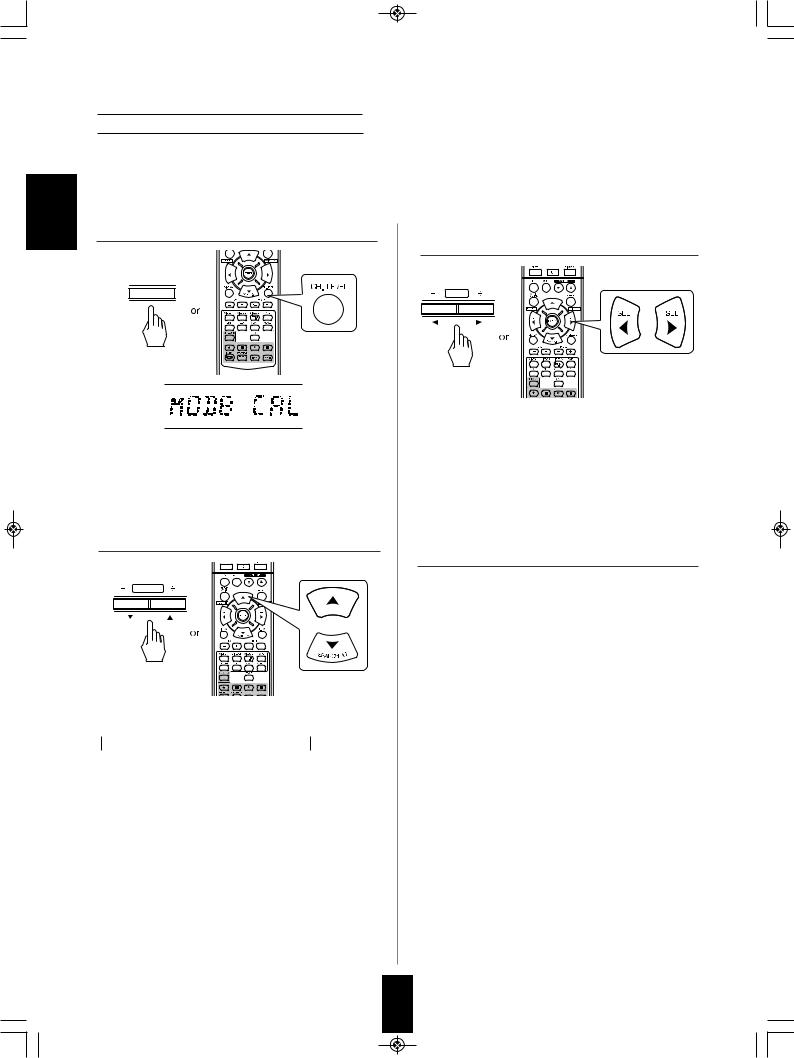
 RD-6506(G)_ENG_110330_RD-6506(G)_ENG 2011-04-14 9:29 20
RD-6506(G)_ENG_110330_RD-6506(G)_ENG 2011-04-14 9:29 20
ENGLISH
Adjusting the current channel level
•After adjusting each channel level with test tone, adjust the channel levels either according to the program sources or to suit your tastes.
•You can adjust the current channel levels as desired. These adjusted levels are just memorized into user’s memory ("CAL"), not into preset memory("REF 1", "REF 2").
1. Press the CHANNEL LEVEL button.
CH.LEVEL
•Then the memory mode ("CAL", etc.) is displayed for several seconds.
•When the memory mode or channel level disappears, press this button again.
2.Select the desired channel.
PRESET
•Each time these buttons are pressed, the corresponding channel is selected as follows:
→ REF 1, 2 (or CAL) ↔ L ↔ C ↔ R ← → <DTS or DD> ↔ SW ↔ SL ↔ SR ←
< >: Possible only when the digital signals from Dolby Digital or DTS program sources that includes LFE signal are input.
•Depending on the speaker settings ("NO") and surround mode, etc., some channels cannot be selected.
•When the SPEAKER button is set to off, only the Front Left, Front Right (and LFE) channels can be selected.
3. Adjust the level of the selected channel as desired.
TUNE
•The LFE level can be adjusted within the range of -10 ~ 0 dB and other channel levels within the range of -15 ~ +15 dB.
•In general, we recommend the LFE level to be adjusted to
0 dB.(However, the recommended LFE level for some early DTS software is -10 dB.) If the recommended levels seem too high, lower the setting as necessary.
4.Repeat the above steps 2 and 3 to adjust each channel level.
20
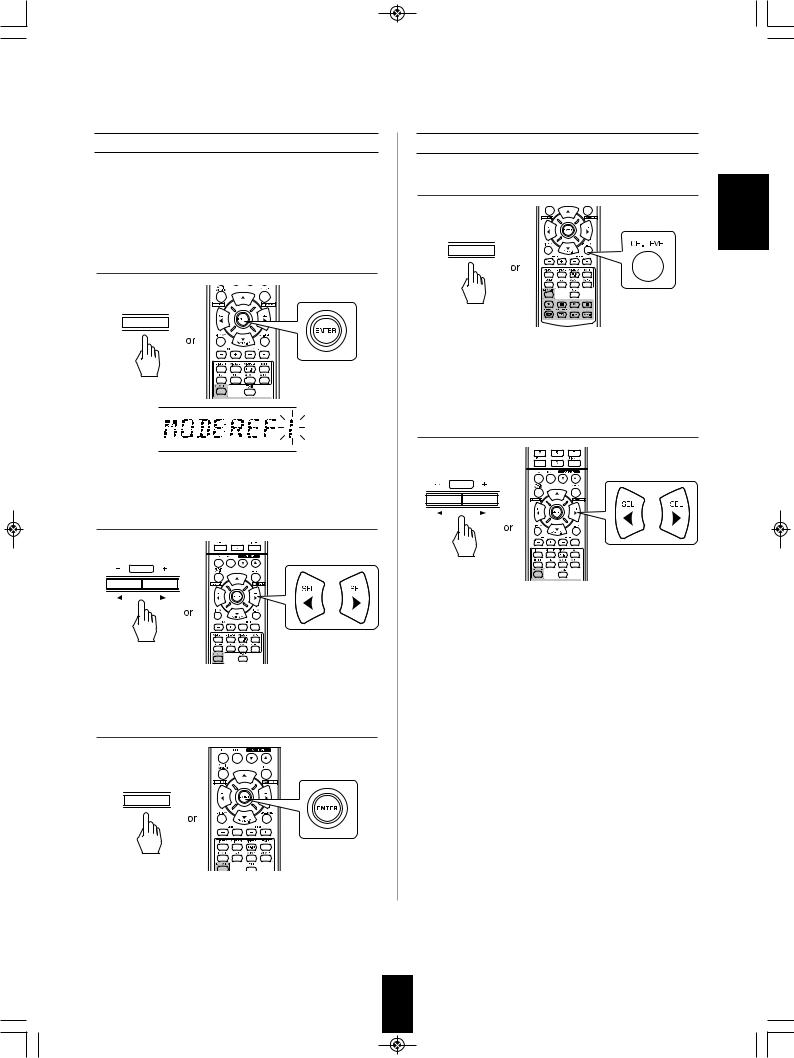
 RD-6506(G)_ENG_110330_RD-6506(G)_ENG 2011-04-14 9:29 21
RD-6506(G)_ENG_110330_RD-6506(G)_ENG 2011-04-14 9:29 21
Memorizing the adjusted channel levels
•You can memorize the adjusted channel levels into preset memory("REF 1", "REF 2") and recall the memorized whenever you want.
1. After performing the steps 1 ~ 4 in "Adjusting the current channel level" procedure on page 20, press the ENTER(/MEMORY) button.
ENTER/MEMO
•Then "1" of "REF 1" indication flickers for several seconds.
2.Select the desired one of REF 1 and REF 2.
TUNE
•If the preset memory disappears, perform the above step
1 again.
3. Confirm your selection.
ENTER/MEMO
•The adjusted channel levels have now been memorized into the selected memory.
Recalling the memorized channel levels
1. Press the CHANNEL LEVEL button.
CH.LEVEL
•"CAL " (or "REF 1", etc.) is displayed for several seconds.
•If the channel level mode display disappears, press this button again.
2. Select the desired one of REF 1 and REF 2.
TUNE
•Then the channel levels memorized into the selected preset memory are recalled.
ENGLISH
21
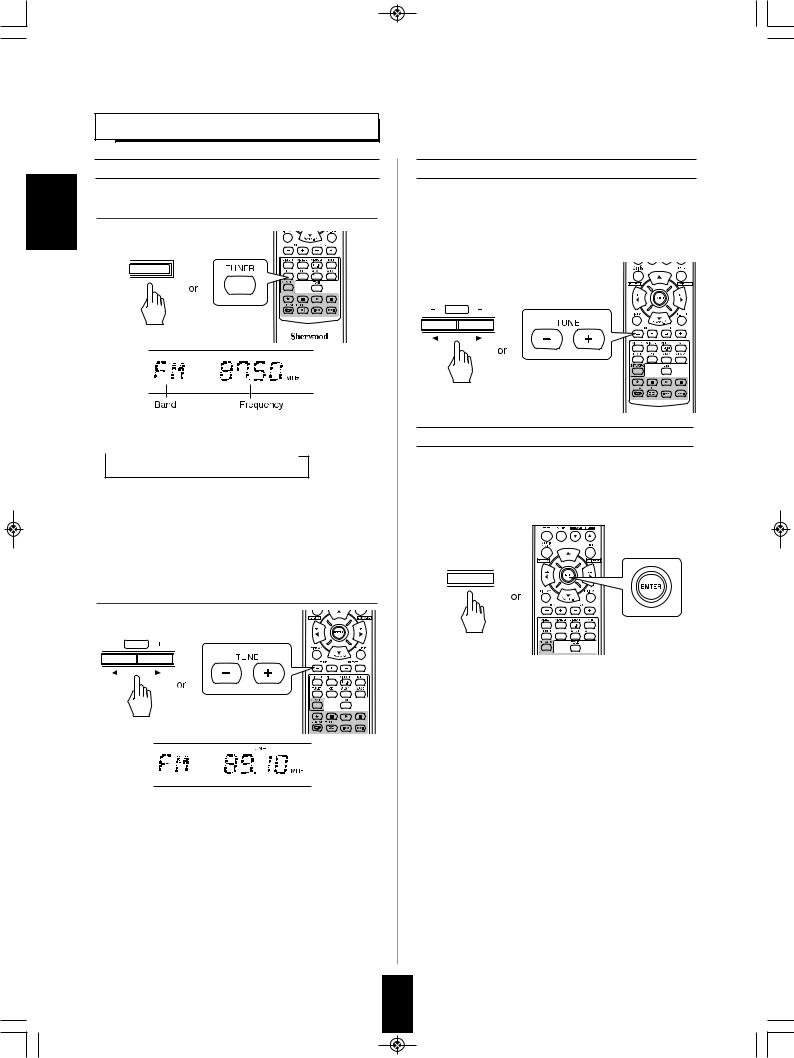
 RD-6506(G)_ENG_110330_RD-6506(G)_ENG 2011-04-14 9:29 22
RD-6506(G)_ENG_110330_RD-6506(G)_ENG 2011-04-14 9:29 22
ENGLISH
LISTENING TO RADIO BROADCASTS
Auto tuning
1. Select the desired band.
BAND
•Each time this button is pressed, the band changes as follows ;
→ FM ST → FM MONO → AM
("ST" lights up) ("ST" goes off)
•When FM stereo broadcasts are poor because of weak broadcast signals, select the FM mono mode to reduce the noise, then FM broadcasts are reproduced in monaural sound.
2.Press the TUNING UP(+)/DOWN(-) buttons for more than 0.5 second.
TUNE
•The tuner will now search until a station of sufficient strength has been found. The display shows the tuned frequency and "TUNE".
•If the station found is not the desired one, simply repeat this operation.
•Weak stations are skipped during auto tuning.
Manual tuning
•Manual tuning is useful when you already know the frequency of the desired station.
•After selecting the desired band, press the TUNING UP(+)
/ DOWN(-) buttons repeatedly until the right frequency has been reached.
TUNE
Auto presetting
•Auto presetting function automatically searches for FM stations only and store them in the memory.
•While listening to FM radio broadcasts, press and hold down the ENTER(/MEMORY) button for more than 2 seconds.
ENTER/MEMO
•Then "AUTO MEM" flickers and this receiver starts auto presetting.
•To stop auto presetting, press this button again.
•Up to 30 FM stations can be stored.
■Notes:
•FM stations of weak strength cannot be memorized.
•To memorize AM stations or weak stations, preform
"Manual presetting" procedure with using "Manual tuning" operation.
22
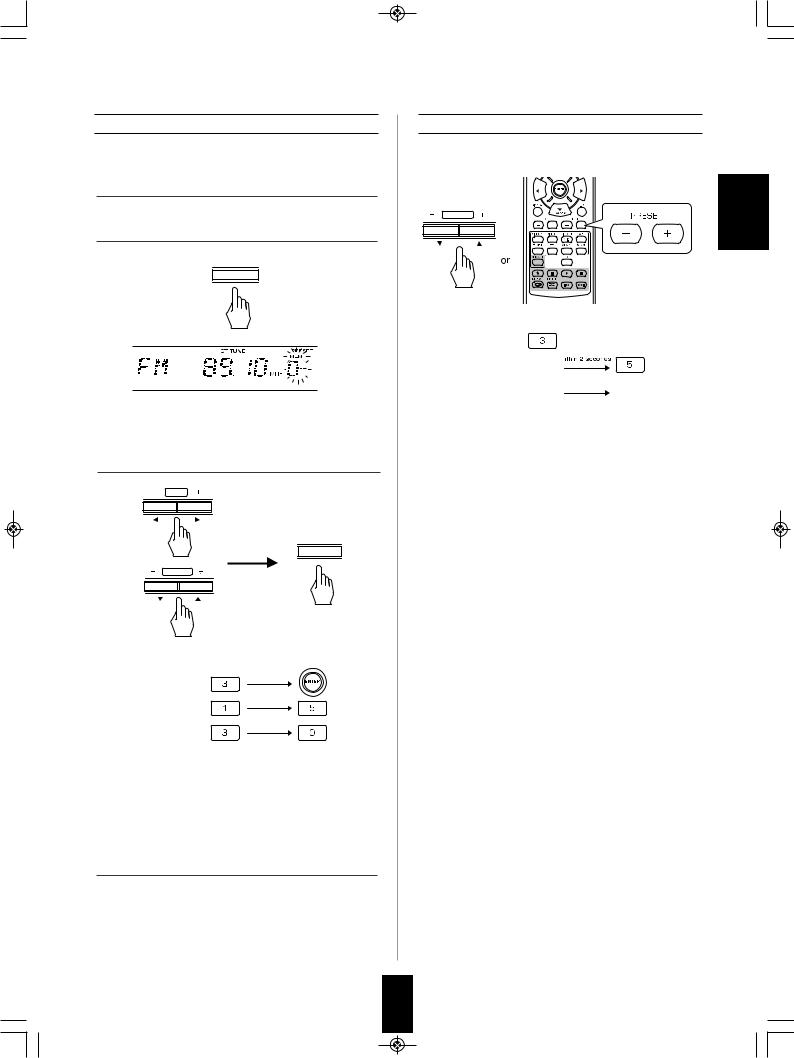
 RD-6506(G)_ENG_110330_RD-6506(G)_ENG 2011-04-14 9:29 23
RD-6506(G)_ENG_110330_RD-6506(G)_ENG 2011-04-14 9:29 23
Manual presetting
•You can store up to 30 preferred stations in the memory.
1.Tune in the desired station with auto or manual tuning.
2.Press the ENTER(/MEMORY) button.
ENTER/MEMO
• "MEM", etc. flicker.
3. Select the desired preset number (1~30) and press the ENTER(/MEMORY) button.
TUNE
ENTER/MEMO
PRESET
• When using the NUMERIC buttons on the remote control.
Examples : For “3” :
For “15” :
For “30” :
•The station has now been stored in the memory.
•When specifying a two digit number with using the NUMERIC buttons, the station is stored automatically without pressing the ENTER(/MEMORY) button.
•A stored frequency is erased from the memory by storing another frequency in its place.
4. Repeat the above steps1 to 3 to memorize other stations.
■MEMORY BACKUP FUNCTION
The following items, set before the receiver is turned off, are memorized.
•INPUT SELECTOR settings
•Surround mode settings
•Preset stations,etc.
Tuning to preset stations
•After selecting the tuner as an input source, select the desired preset number.
PRESET
• When using the NUMERIC buttons on the remote control.
Examples: For “3” :
For “15” : 

For “30” : 









ENGLISH
23
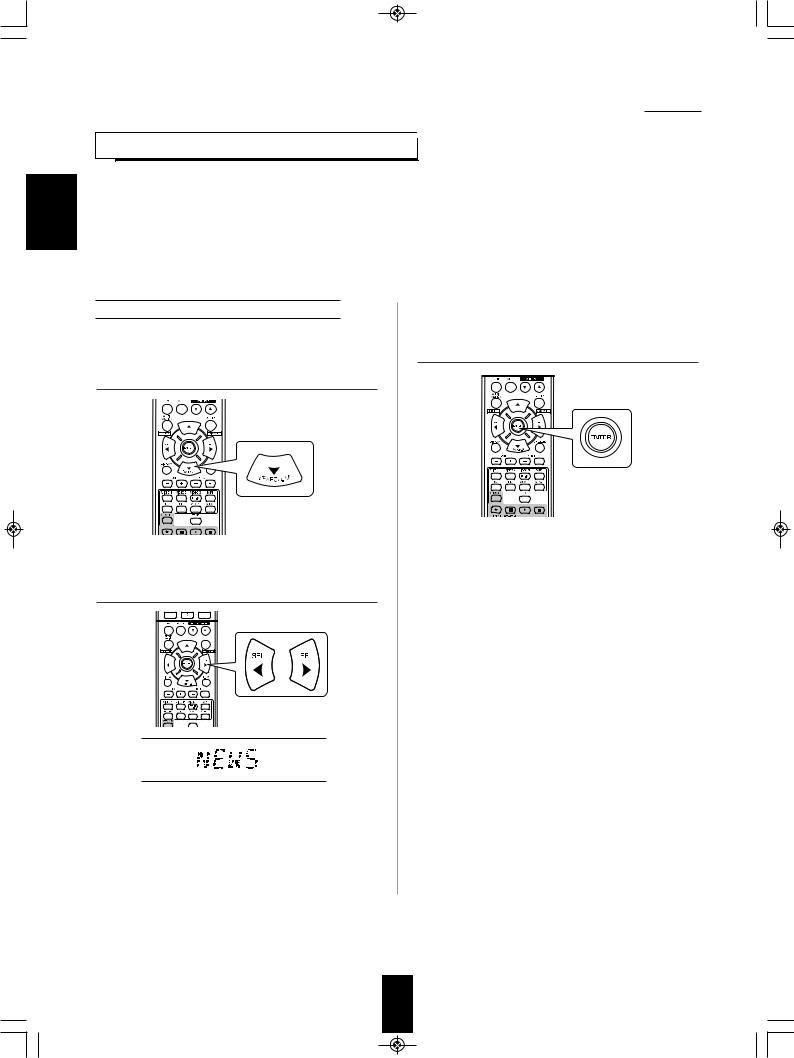
 RD-6506(G)_ENG_110330_RD-6506(G)_ENG 2011-04-14 9:29 24
RD-6506(G)_ENG_110330_RD-6506(G)_ENG 2011-04-14 9:29 24
ENGLISH
RDS Tuner (Regional Option for some countries in Europe, etc.)
LISTENING TO RDS BROADCASTS(FM ONLY) 
RDS(Radio Data System) is a method for sending information signals together with the transmitter signals. Your tuner is capable of translating these signals and putting the information on the display. These codes contain the following information. Program Service name (PS), A list of Program Types (PTY), Radio Text (RT).
■Notes :
•In the other countries, RDS tuner function cannot be available.
•RDS is only possible in the FM band.
•RDS searches for the preset stations only. If no stations have been stored in the memory, or if the program type could not be found among the preset stations, “NO PTY” is displayed.
Therefore, preset the radio stations before searching for RDS stations.
Searching for stations by program type
• You can search for stations by program type.
1. In the FM mode, press the SEARCH MODE button.
• “SEARCH” is displayed for several seconds.
2. While displaying "SEARCH", select the desired program type.
•Each time these buttons are pressed, one of different types of programs is selected.
(NEWS, AFFAIRS, INFO, SPORT, EDUCATE, DRAMA, CULTURE, SCIENCE, VARIED, POP M, ROCK M,
EASY M, LIGHT M, CLASSICS, OTHER M, WEATHER,
FINANCE, CHILDREN, SOCIAL, RELIGION, PHONE IN, TRAVEL, LEISURE, JAZZ, COUNTRY, NATION M, OLDIES, FOLK M, DOCUMENT)
•If "SEARCH" disappears, press the SEARCH MODE button again.
3. While displaying the selected program type, press the ENTER button.
•The tuner starts searching through the preset station for a match.
•When a station is found, the search stops and the station plays.
•If no station is found, “NO PTY” is displayed.
24
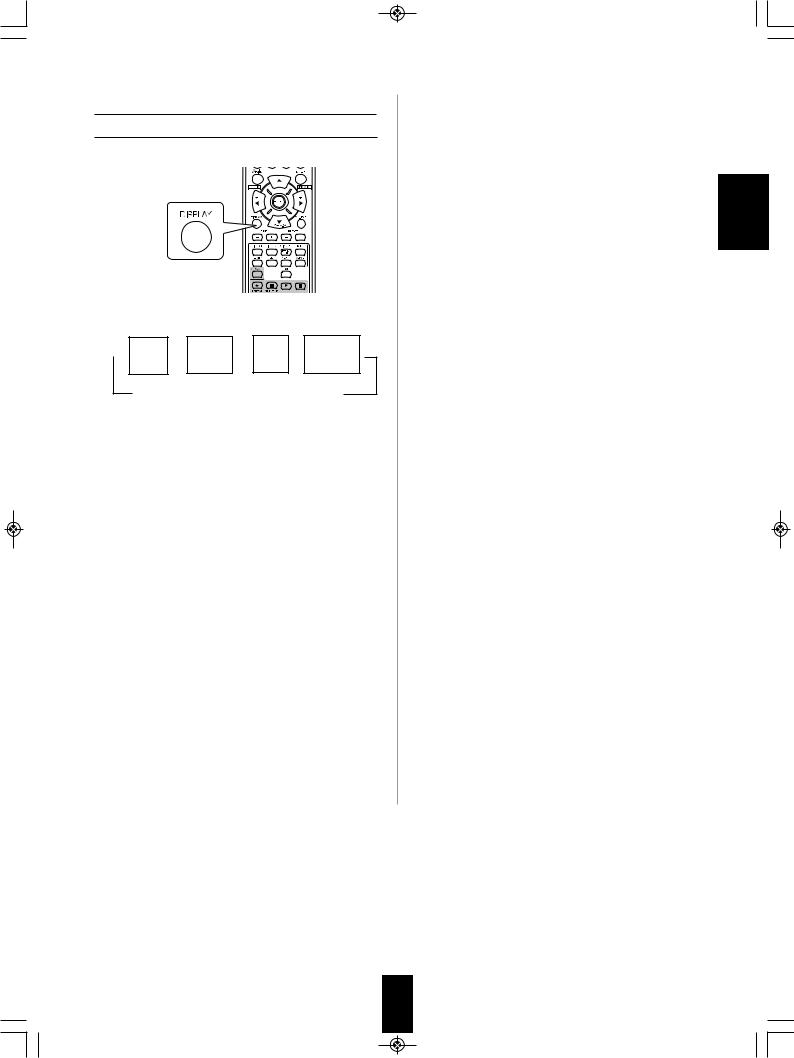
 RD-6506(G)_ENG_110330_RD-6506(G)_ENG 2011-04-14 9:29 25
RD-6506(G)_ENG_110330_RD-6506(G)_ENG 2011-04-14 9:29 25
Displaying RDS information
In the FM mode,
ENGLISH
•Each time this button is pressed, the display mode changes as follows:
Program → Volume → Surroundmode → Signalinput → Service name
(PS)
Input |
← |
Radio |
← |
Program |
← |
source |
Type |
||||
(Frequency) |
|
Text (RT) |
|
(PTY) |
|
|
|
|
|
||
|
|
|
|
|
|
*Program Service Name(PS)-The name of the radio station.
*Program Type(PTY)-This indicates the kind of program currently being broadcast.
*Radio Text(RT)-Messages sent by the radio station. For example, a talk radio station may provide a phone number as RT.
•If the signals are too weak or no RDS service is available, "NO NAME", "NO PTY" or "NO TEXT" will be displayed.
25

 RD-6506(G)_ENG_110330_RD-6506(G)_ENG 2011-04-14 9:29 26
RD-6506(G)_ENG_110330_RD-6506(G)_ENG 2011-04-14 9:29 26
ENGLISH
RECORDING
•The digital signals from the coaxial, optical digital input or HDMI IN can be heard but cannot be recorded.
•When recording the analog signals from CD, VIDEO 1~2, be sure to select the analog input. (For details, refer to "When CD, VIDEO 1~2 is selected as an input source" on page 14.)
•The volume and tone (bass, treble) settings have no effect on the recording signals.
Recording with TAPE
1. Select the desired input as a recording source except for TAPE.
2. Start recording on the TAPE.
3. Start play on the desired input.
Dubbing from video components onto VIDEO 1
1. Select the VIDEO 2 as a recording source.
VIDEO
2. Start recording on the VIDEO 1.
3. Start play on the desired input.
•The audio and video signals from the desired input will be dubbed onto the VIDEO 1 and you can enjoy them on the TV set and from the speakers.
26
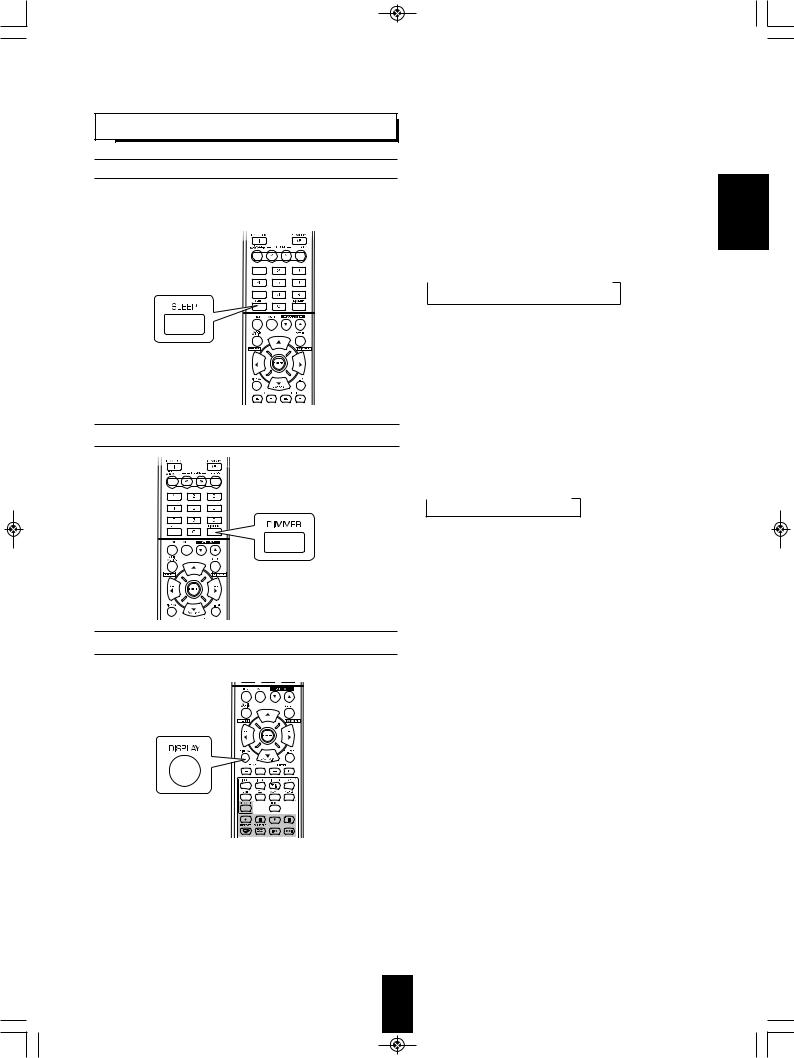
 RD-6506(G)_ENG_110330_RD-6506(G)_ENG 2011-04-14 9:29 27
RD-6506(G)_ENG_110330_RD-6506(G)_ENG 2011-04-14 9:29 27
OTHER FUNCTIONS
Operating the sleep timer
•The sleep timer allows the system to continue to operate for a specified period of time before automatically shutting off.
•To set the receiver to automatically turn off after the specified period of time.
Adjusting the brightness of the fluorescent display
Displaying the operation status
During playback,
•Each time this button is pressed, the sleep time changes as follows:
→ 10 → 20 → 30 → --- → 90 → OFF
Unit : minutes
•While operating the sleep timer, "  " lights up.
" lights up.
•When the sleep time is selected, the fluorescent display is dimly lit.
•Each time this button is pressed, the brightness of the fluorescent display changes as follows:
→ ON → dimmer → OFF
•In the display OFF mode, pressing some buttons cancel the display OFF mode to display the operation status.
•Each time this button is pressed, the display mode changes as follows:
|
|
→ |
Volume |
→ |
Surroundmode |
→ |
Signalinput |
→ |
sourceInput |
|
|
|
|
|
|||||||||
|
|
|
|
|
|
|
|
|
|
|
|
|
|
|
|
|
|
|
|
|
|
|
|
•When the RDS tuner function is available in your country, for details on the FM mode information, see “Displaying RDS information” on page 25.
ENGLISH
27

 RD-6506(G)_ENG_110330_RD-6506(G)_ENG 2011-04-14 9:29 28
RD-6506(G)_ENG_110330_RD-6506(G)_ENG 2011-04-14 9:29 28
ENGLISH
CONFIRMING THE HDMI FUNCTION
To use the HDMI control functions properly, it is recommend to confirm the HDMI control functions usable with each connected component by performing the following operations.
■Note :
•Some HDMI control functions may not work with certain components and TV that are not compatible with them.
Before operation
•Check that this receiver, TV and player, etc are connected by HDMI cabels.
•Check that the HDMI control of TV and the HDMI-connectable player are enabled. (For details on the setups of TV and player, refer to their operating instructions.)
•Set the HDMI CONTROL and the POWER CONROL to ON to enable the HDMI control of this receiver. (For details, refer to “SETTING THE HDMI” on page 42.)
Confirming the basic HDMI operations
1. Turn the power on for all the components connected by HDMI cables.
2. Switch the TV input to the HDMI input connected to this receiver.
3. Switch this unit input to the HDMI input source.
• Confirm that its picture is displayed and the sound is heard from the speakers properly.
Confirming the HDMI control functions
1. Turn the power on for all the components connected by HDMI cables.
2. Turn the TV off to enter the standby mode.
•Confirm that all the components are turned off.
3.With all the components off, start playback on a player (connected by HDMI cable).
•Confirm that all the components are turned on and the inputs of this unit and TV are switched automatically.
28

 RD-6506(G)_ENG_110330_RD-6506(G)_ENG 2011-04-14 9:29 29
RD-6506(G)_ENG_110330_RD-6506(G)_ENG 2011-04-14 9:29 29
System Setup
•The setup menu is displayed on the fluorescent display and allows you to perform the setup procedures easily. In most situations, you will only need to set this once during the installation and layout of your home theater, and it rarely needs to be changed later.
The setup menu consists of 6 main menus ; system, input, speaker setup, CH level, parameter and HDMI. These menus are then divided up into various sub-menus.
■Navigating through the setup menu
•The explanations here assume you are using the buttons on the remote control when performing the setup menu operation. However, you can use the buttons on the front panel as well.
The buttons on the front panel correspond to those on the remote control as shown below.
ENGLISH
SETUP |
ENTER / MEMO |
TUNE |
PRESET |
MAIN MENU
1. Turn the setup menu on.
•The setup menu will be shown.
•To turn the menu off, press this button again.
2. Select the desired menu using the CURSOR UP(▲)/ DOWN(▼) buttons.
3. Confirm your selection.
•When selecting "SYSTEM", see "SETTING THE SYSTEM" on page 31.
•When selecting "INPUT", see "SETTING THE INPUT" on page 33.
•When selecting "SPK SET", see "SETTING THE
SPEAKER SETUP" on page 34.
•When selecting "CH LEVEL", see "SETTING THE CH LEVEL" on page 38.
•When selecting "PARAMTR", see "SETTING THE PARAMETER" on page 40.
•When selecting "HDMI", see "SETTING THE HDMI" on page 42.
•When selecting "EXIT", the setup menu will be turned off.
29

 RD-6506(G)_ENG_110330_RD-6506(G)_ENG 2011-04-14 9:29 30
RD-6506(G)_ENG_110330_RD-6506(G)_ENG 2011-04-14 9:29 30
ENGLISH
■Setup menu flow
• The setup menu flow is as follows :
SW M : NORM / SW + |
|
TONE : OFF |
/ ON |
A.P.S : OFF / 2H / 4H / 6H |
BASS : 0 / - 10 ~ + 10 |
|
|
RETURN |
TRE : 0 / - 10 ~ + 10 |
|
VID 1 CFG
VID 2 CFG
CD CFG
RETURN
SPK SET |
CONFIG |
AUD : OPT / COX 1 / COX 2 / - - -
AUTO : ON / OFF
RETURN
AUD : OPT / COX 1 / COX 2 / - - -
AUTO : ON / OFF
RETURN
AUD : OPT / COX 1 / COX 2 / - - -
AUTO : ON / OFF
RETURN
F : LARGE / SMALL
C : LARGE / SMALL / NO
S : LARGE / SMALL / NO
SW : YES / NO
RETURN
X-OVER |
FC : 40 / 50 / 80 / 100 / 150 / 200 |
|
|
RETURN |
|
DISTANCE |
UNIT : M |
/ FT |
|
RETURN |
L : 3.0 M / 0.1 ~ 9.0 |
L : 10.0 FT / 0.5 ~ 30.0 |
||||||
|
|
C : 3.0 M |
/ |
0.1 ~ 9.0 |
C : 10.0 FT |
/ |
0.5 ~ 30.0 |
||
|
|
R : 3.0 M |
/ |
0.1 ~ 9.0 |
R : 10.0 FT |
/ |
0.5 ~ 30.0 |
||
|
|
SR : 3.0 M |
/ |
0.1 ~ 9.0 |
SR : 10.0 FT |
/ |
0.5 ~ 30.0 |
||
|
|
SL : 3.0 M |
|
/ |
0.1 ~ 9.0 |
SL : 10.0 FT |
|
/ |
0.5 ~ 30.0 |
|
|
SW : 3.0 M / 0.1 ~ 9.0 |
SW : 10.0 FT / 0.5 ~ 30.0 |
||||||
|
|
RETURN |
|
|
|
RETURN |
|
|
|
|
MODE : CAL / REF 1 / REF 2 |
|
|
|
|
|
|
|
|
|
L : 0 dB / -15 ~ + 15 |
|
|
|
|
|
|
|
|
|
C : 0 dB / -15 ~ + 15 |
|
|
|
|
|
|
|
|
|
R : 0 dB / -15 ~ + 15 |
|
|
|
|
|
|
|
|
|
SR : 0 dB / -15 ~ + 15 |
|
|
|
|
|
|
|
|
|
SL : 0 dB / -15 ~ + 15 |
|
|
|
|
|
|
|
|
|
SW : 0 dB / -15 ~ + 15 |
|
|
|
|
|
|
|
|
|
DD : 0 dB / -10 ~ 0 |
|
|
|
|
|
|
|
|
|
DTS : 0 dB / -10 ~ 0 |
|
|
|
|
|
|
|
|
|
RETURN |
|
|
|
|
|
|
|
|
|
PANO : OFF / ON |
|
|
|
|
|
|
|
|
|
C.WIDTH : 3 / 0 ~ 7 |
|
|
|
|
|
|
|
|
|
DIMEN : 0 / -3 ~ +3 |
|
|
|
|
|
|
|
|
|
DRC DD |
DRC : OFF / MID / MAX |
|
|
|
|
|
||
|
|
RETURN |
|
|
|
|
|
|
|
|
RETURN |
|
|
|
|
|
|
|
|
HDMI |
HDMI : AMP / THRU |
|
|
|
|
|
|
|
|
|
CEC : OFF / ON |
|
|
|
|
|
|
|
|
|
PWR : OFF / ON |
|
|
|
|
|
|
|
|
RETURN
 EXIT
EXIT
•When "RETURN" is selected on a sub-menu, it will return to the previous menu.
•When the AUDIO ASSIGN(/RETURN) button is pressed on a sub-menu, it will return to the previous menu, too.
■Note : During setup menu operation, only the (POWER ON/)STANDBY button and the buttons required for system setup will function.
30
